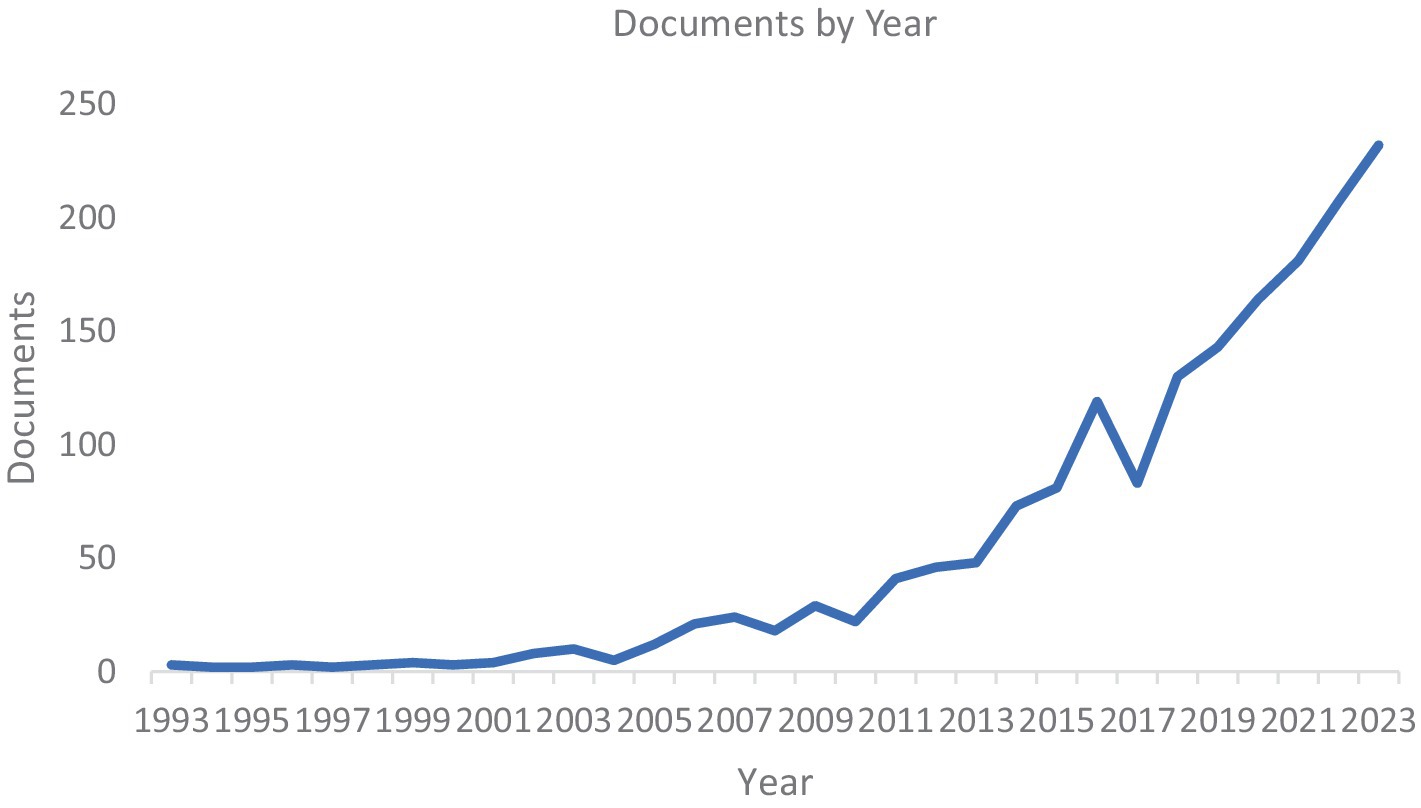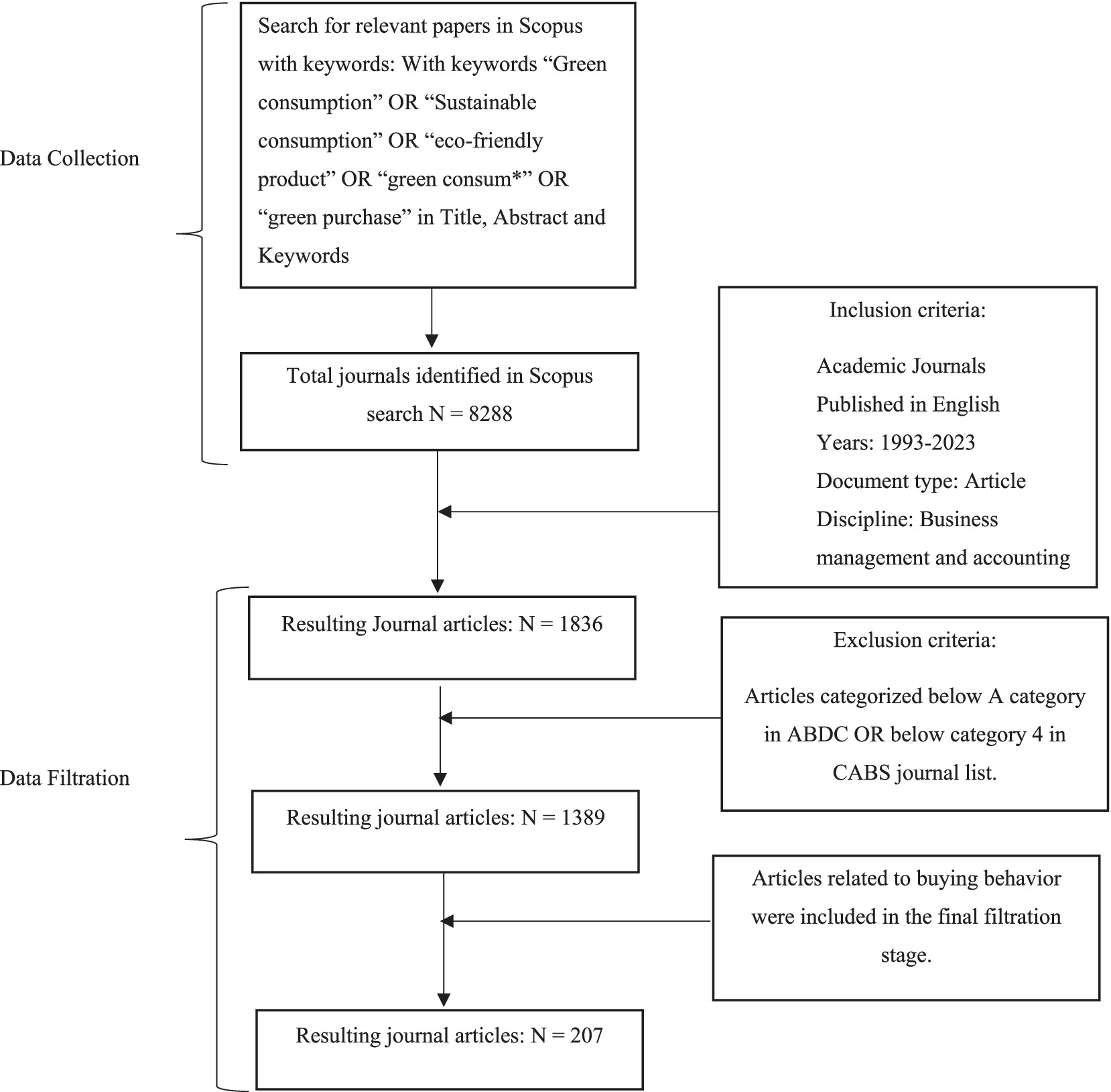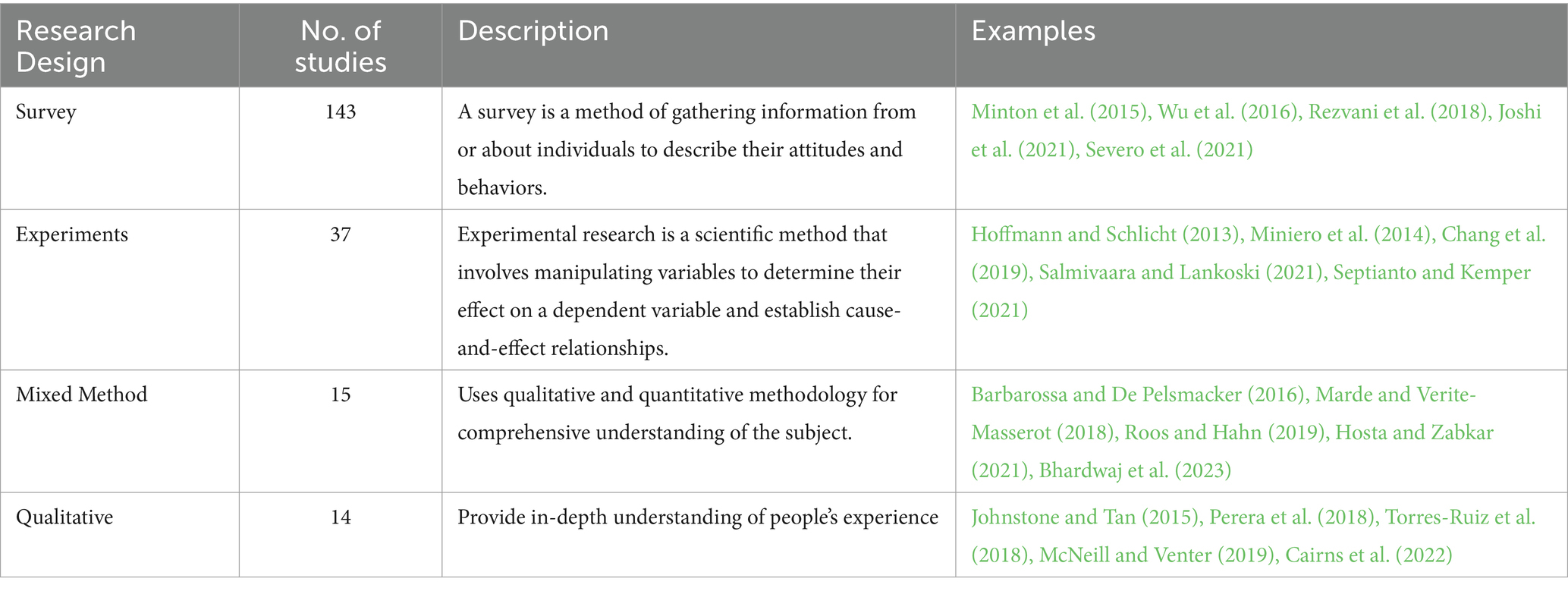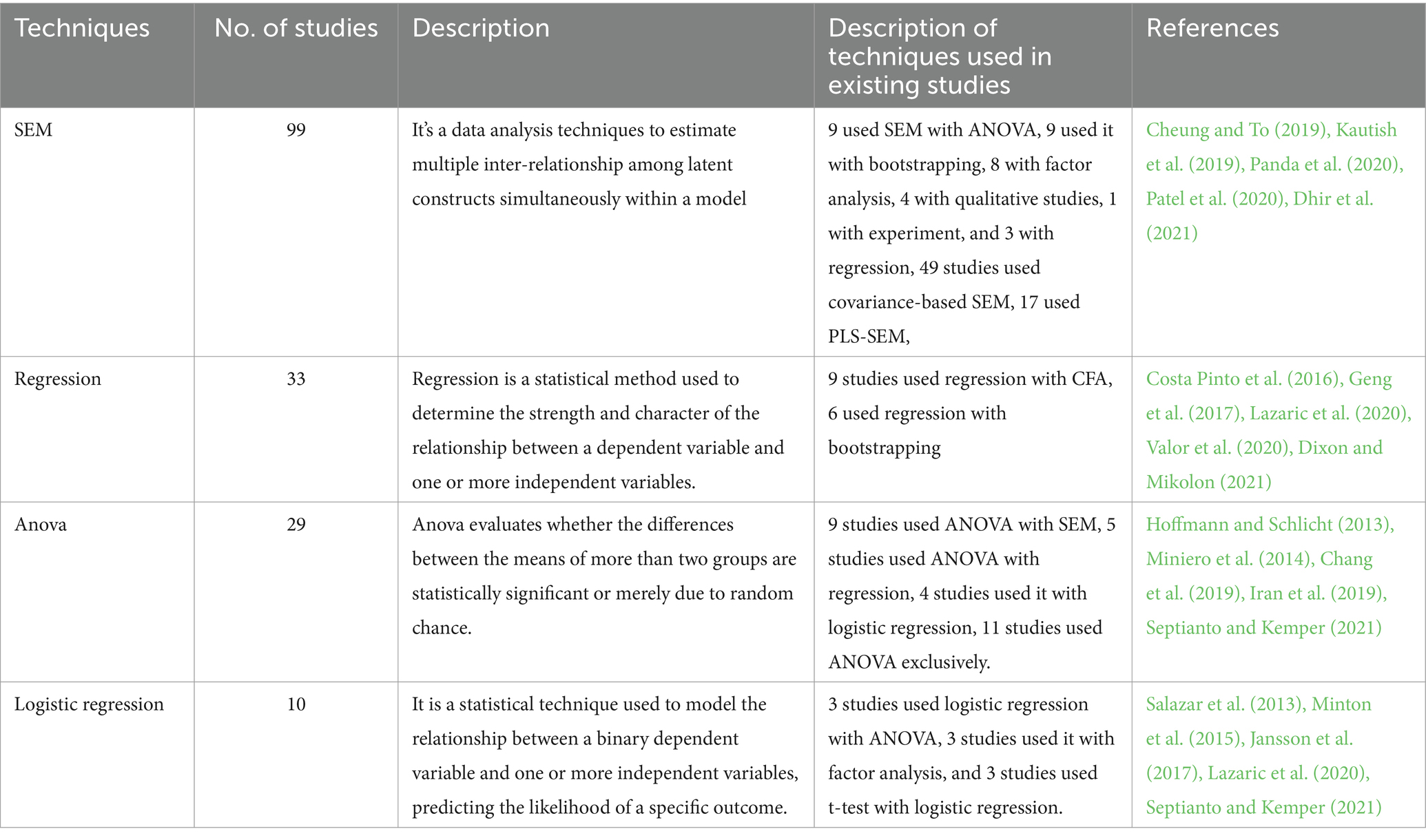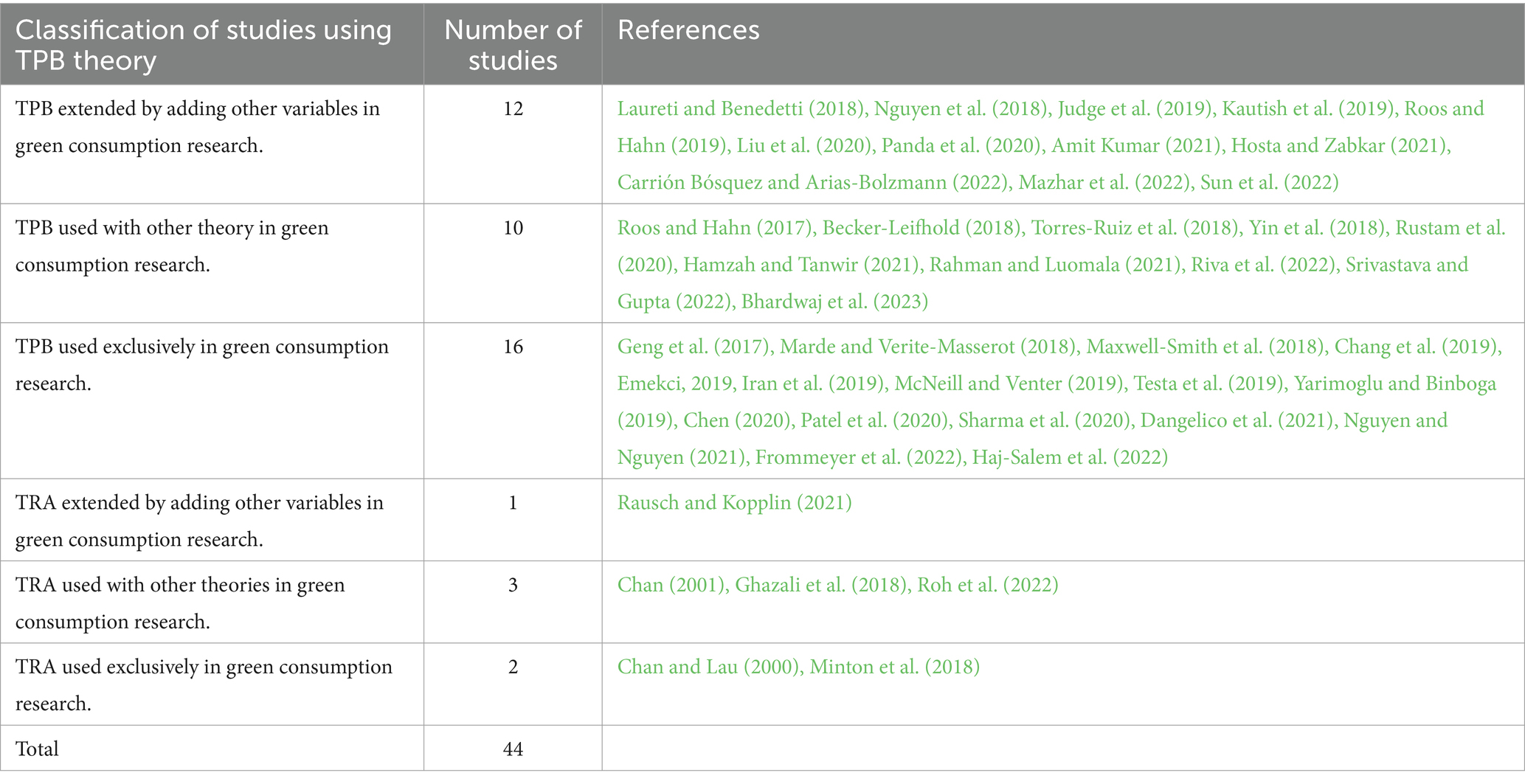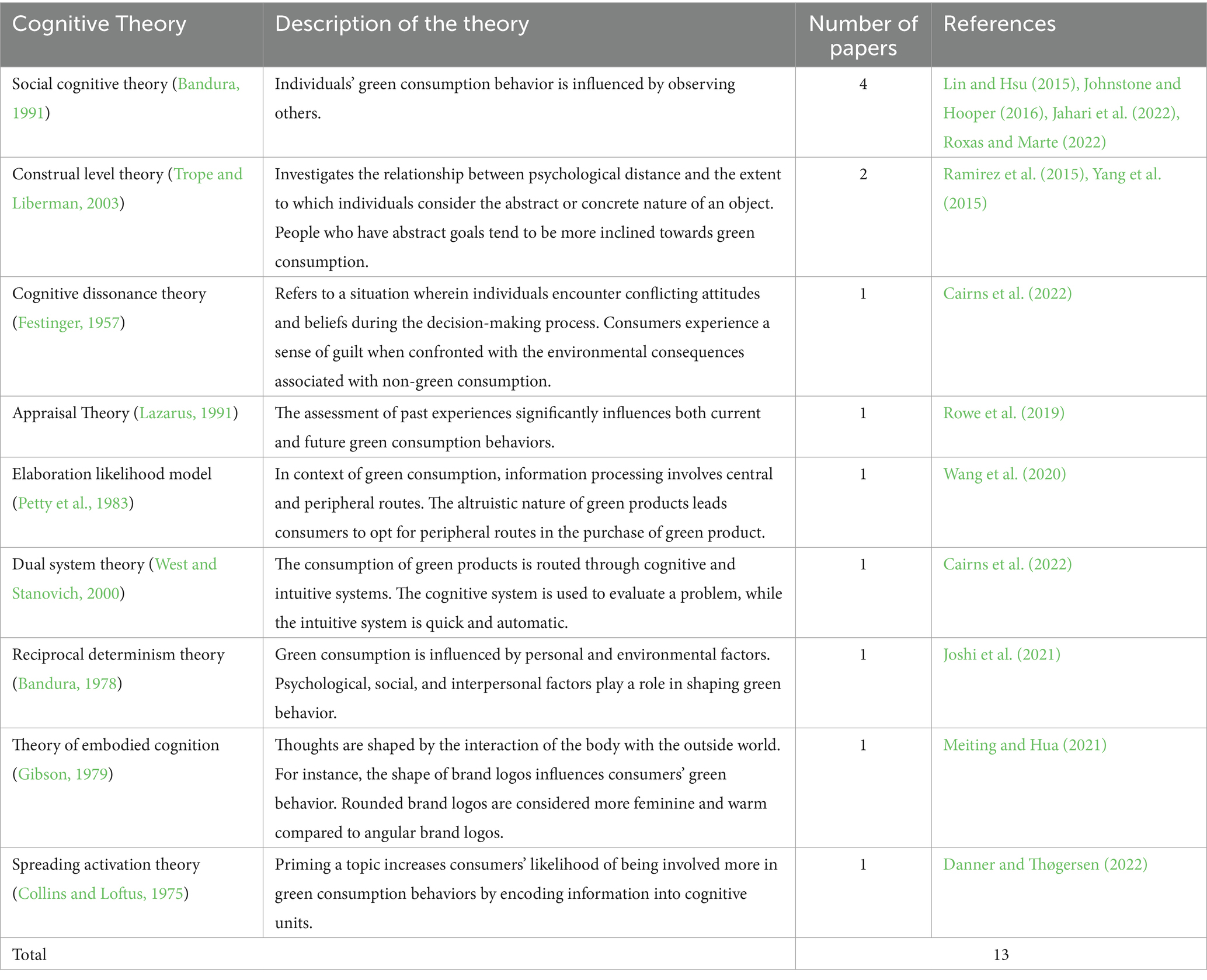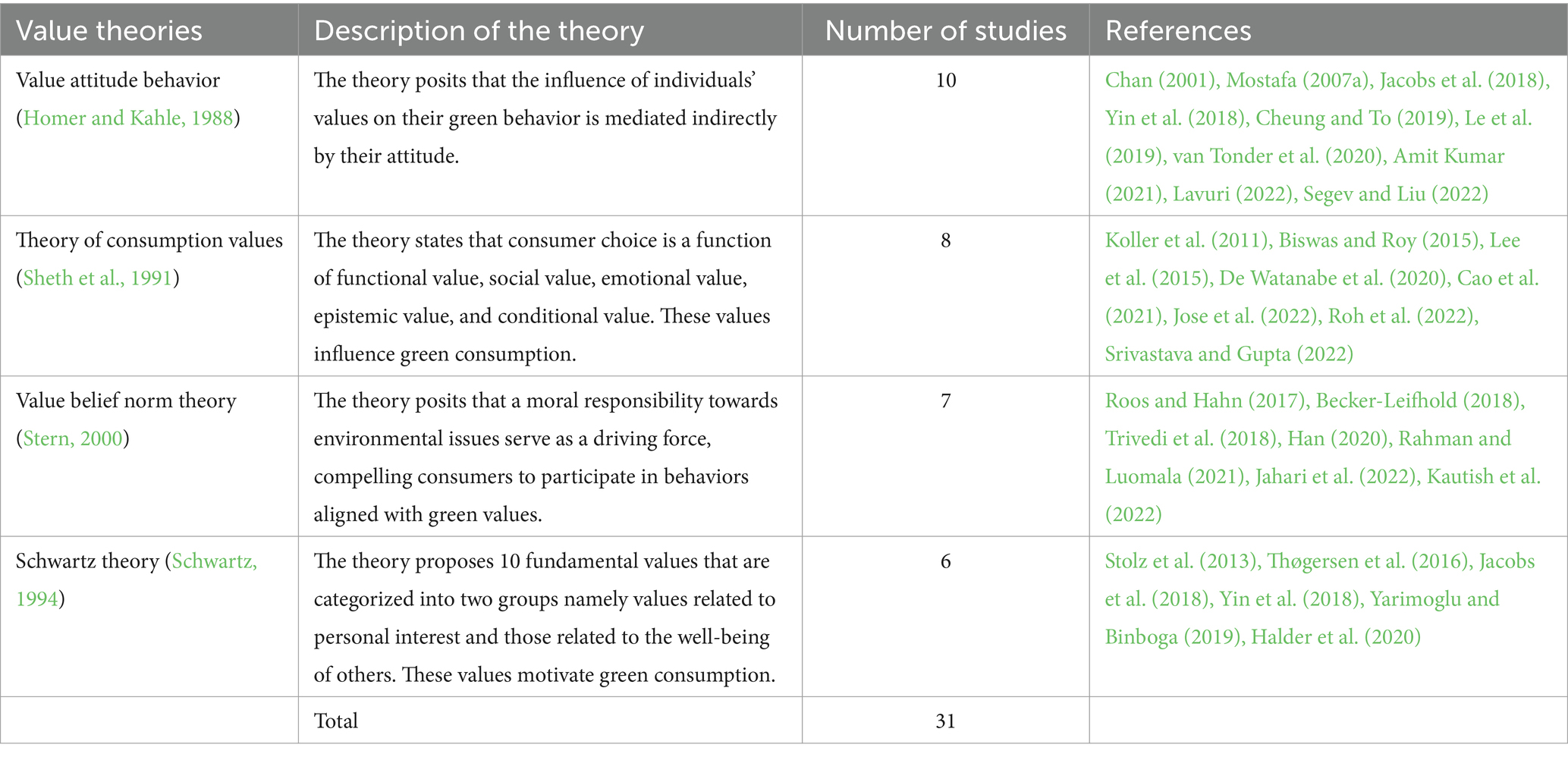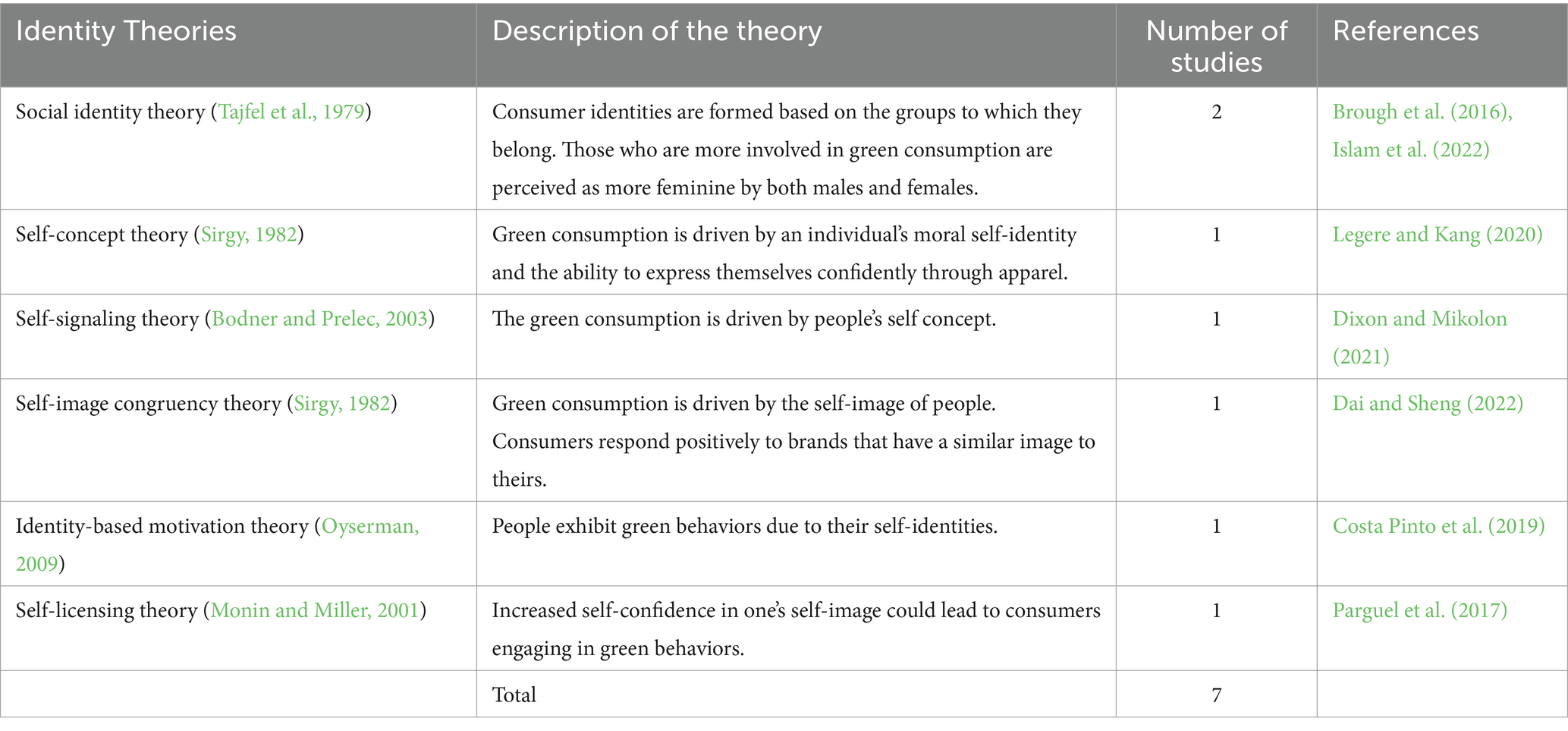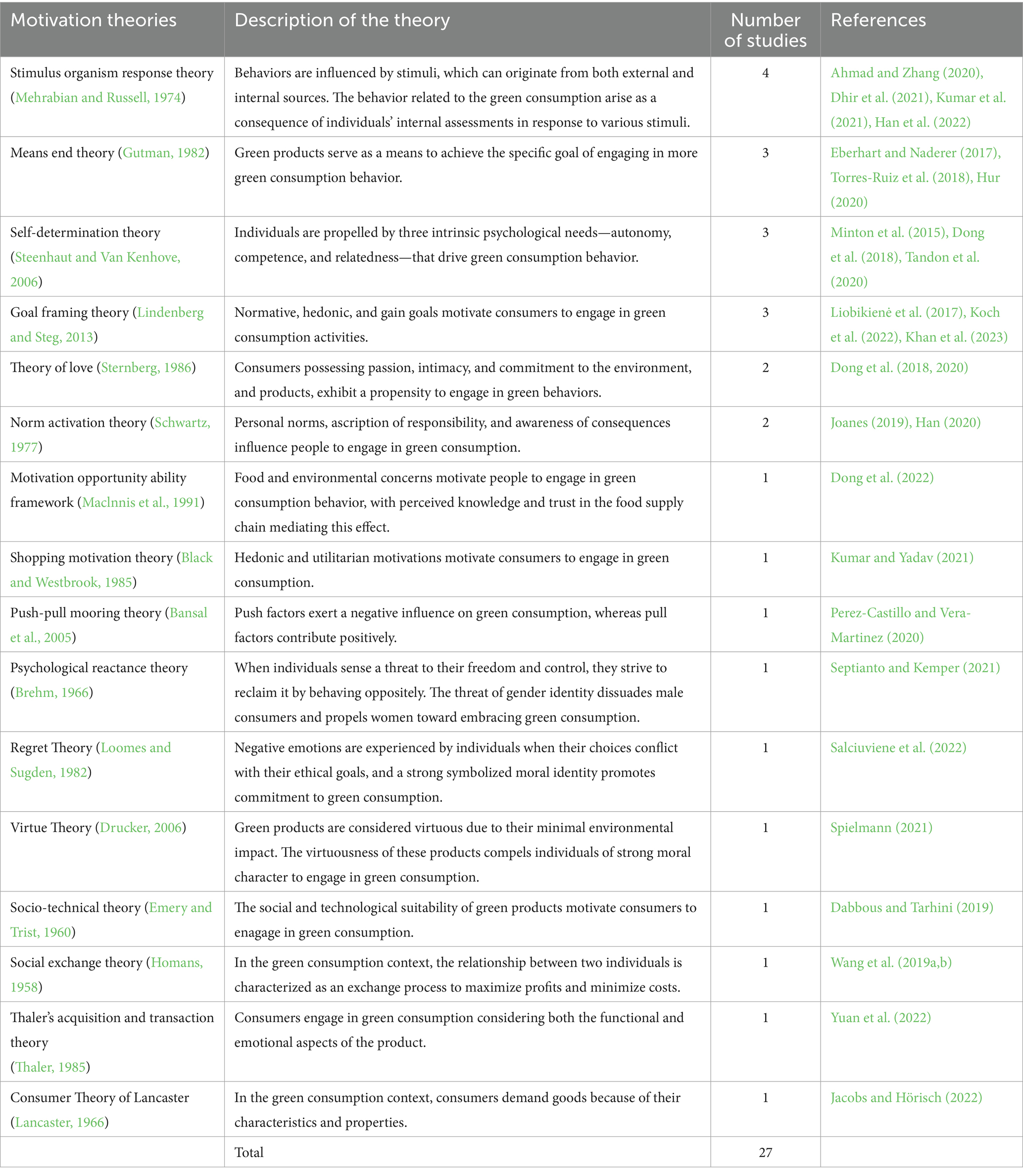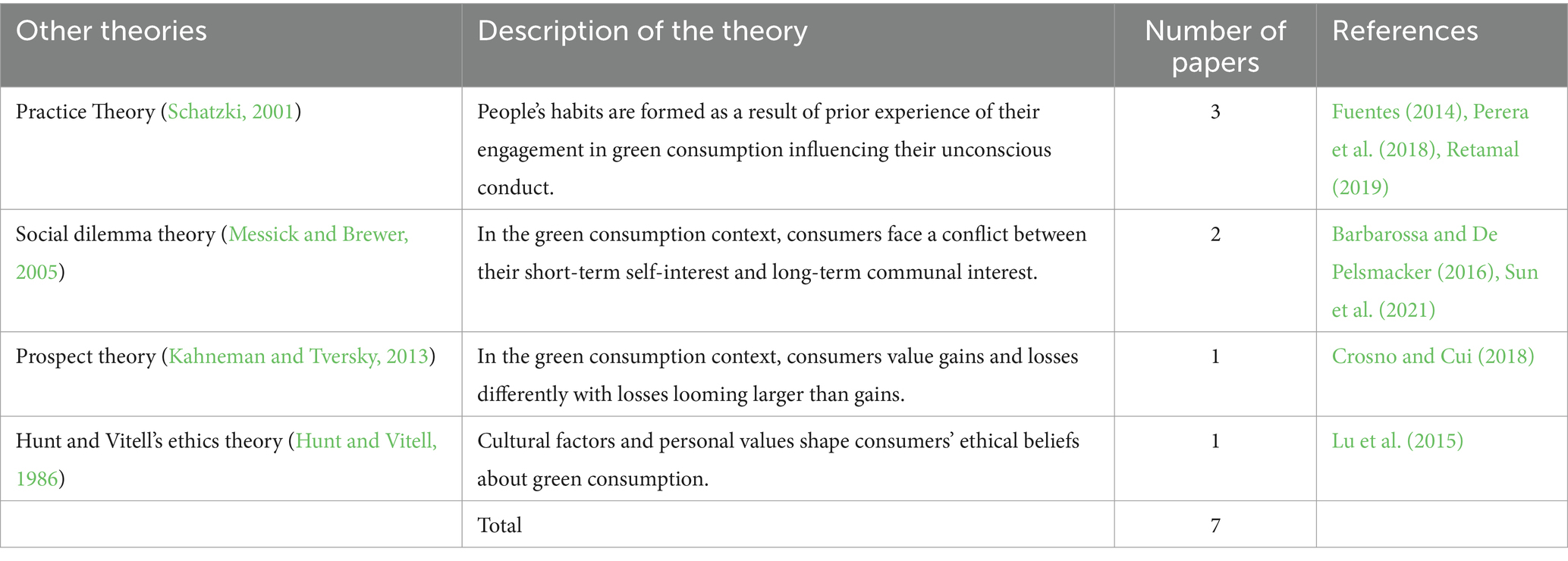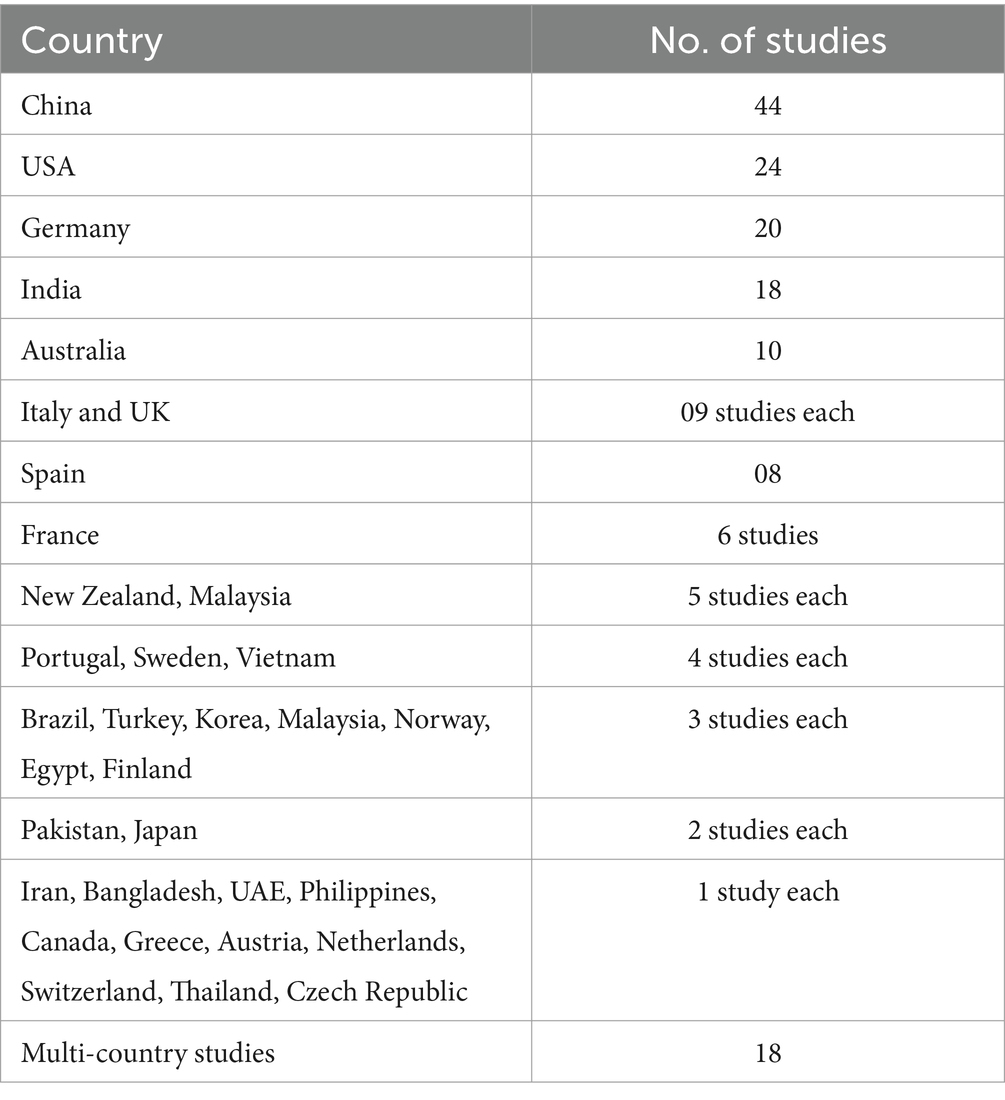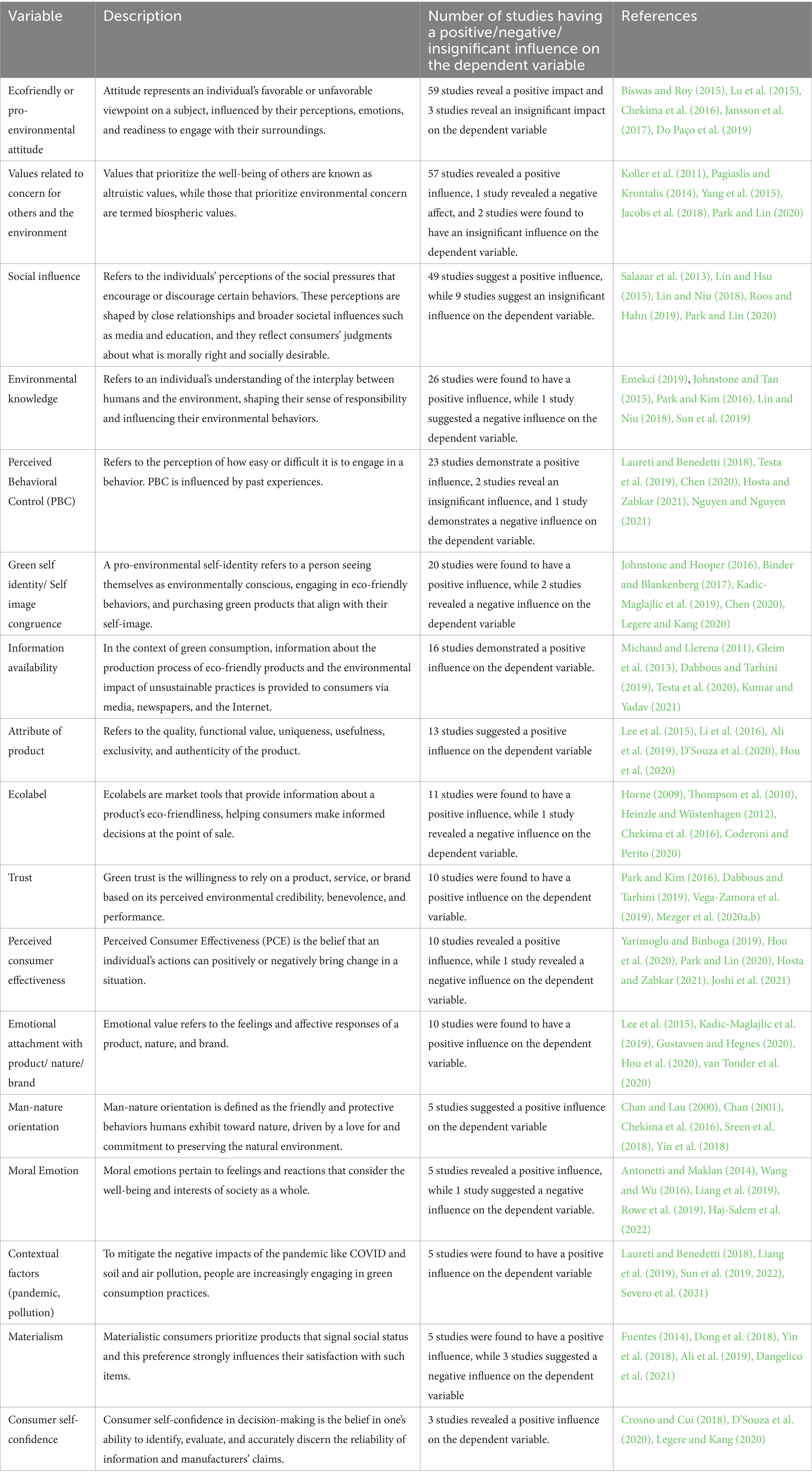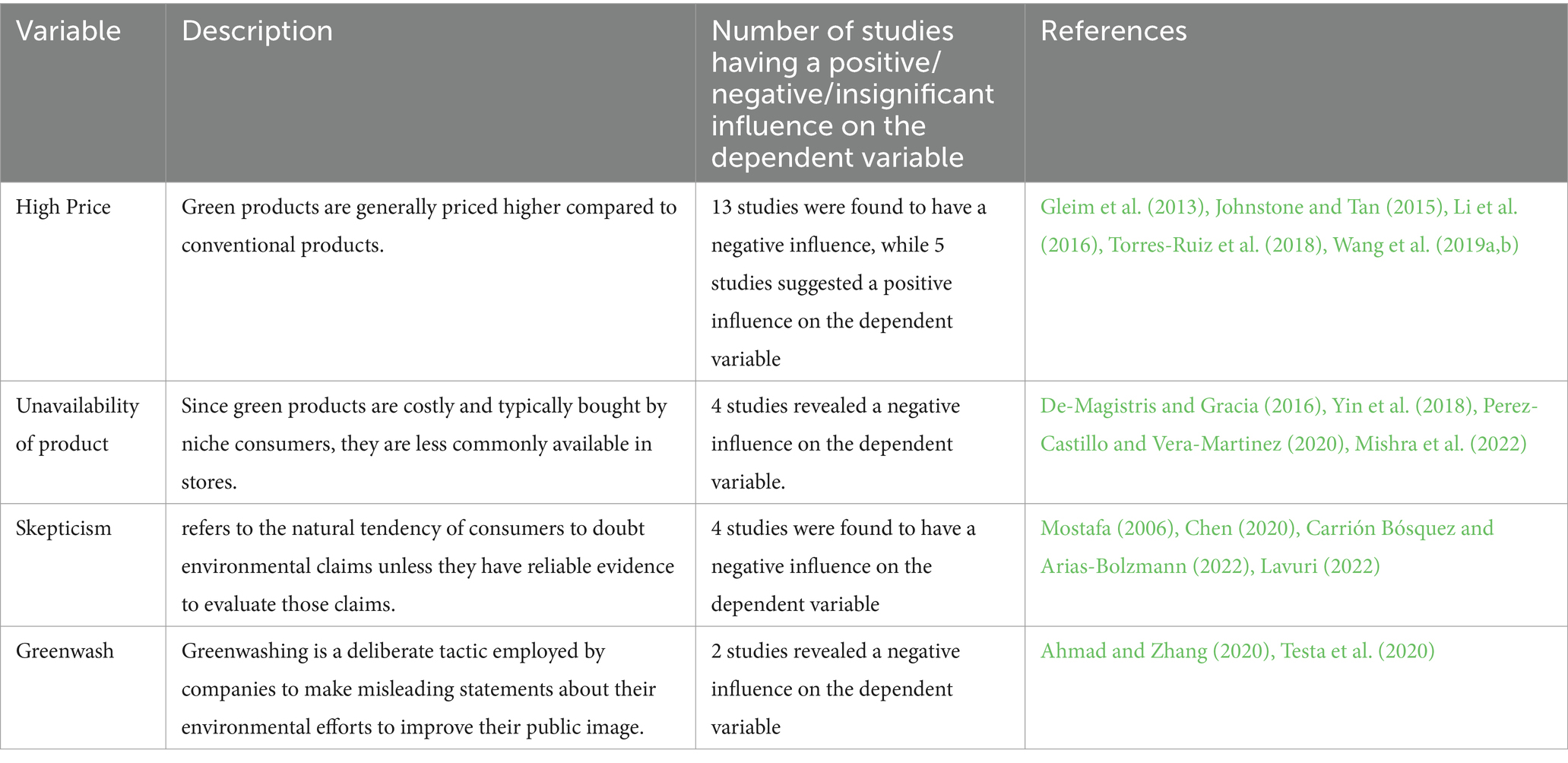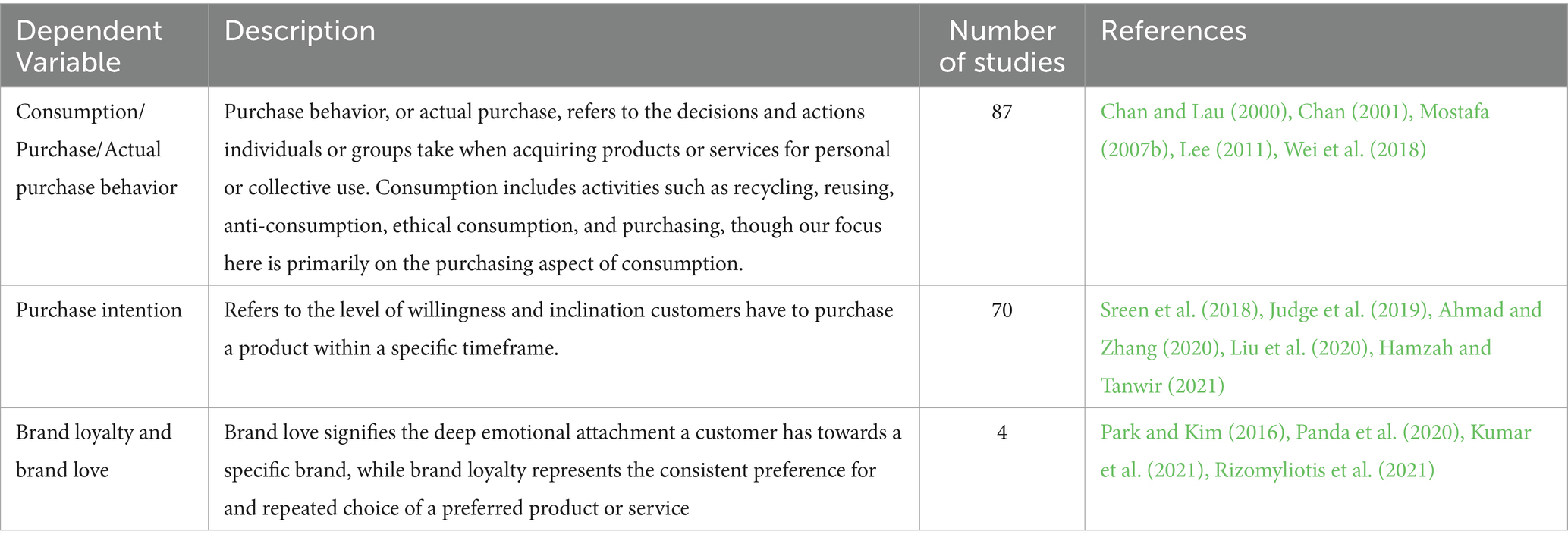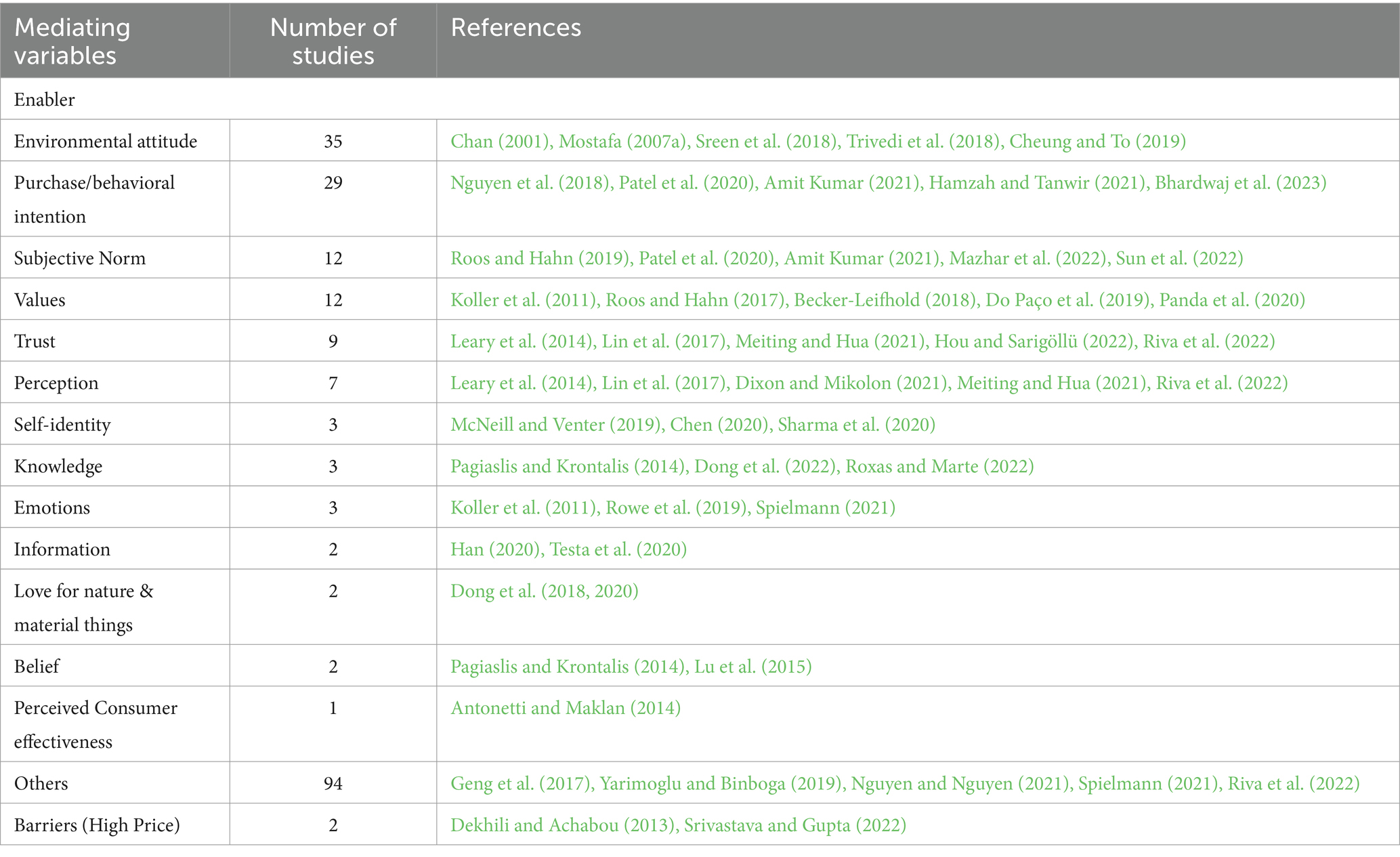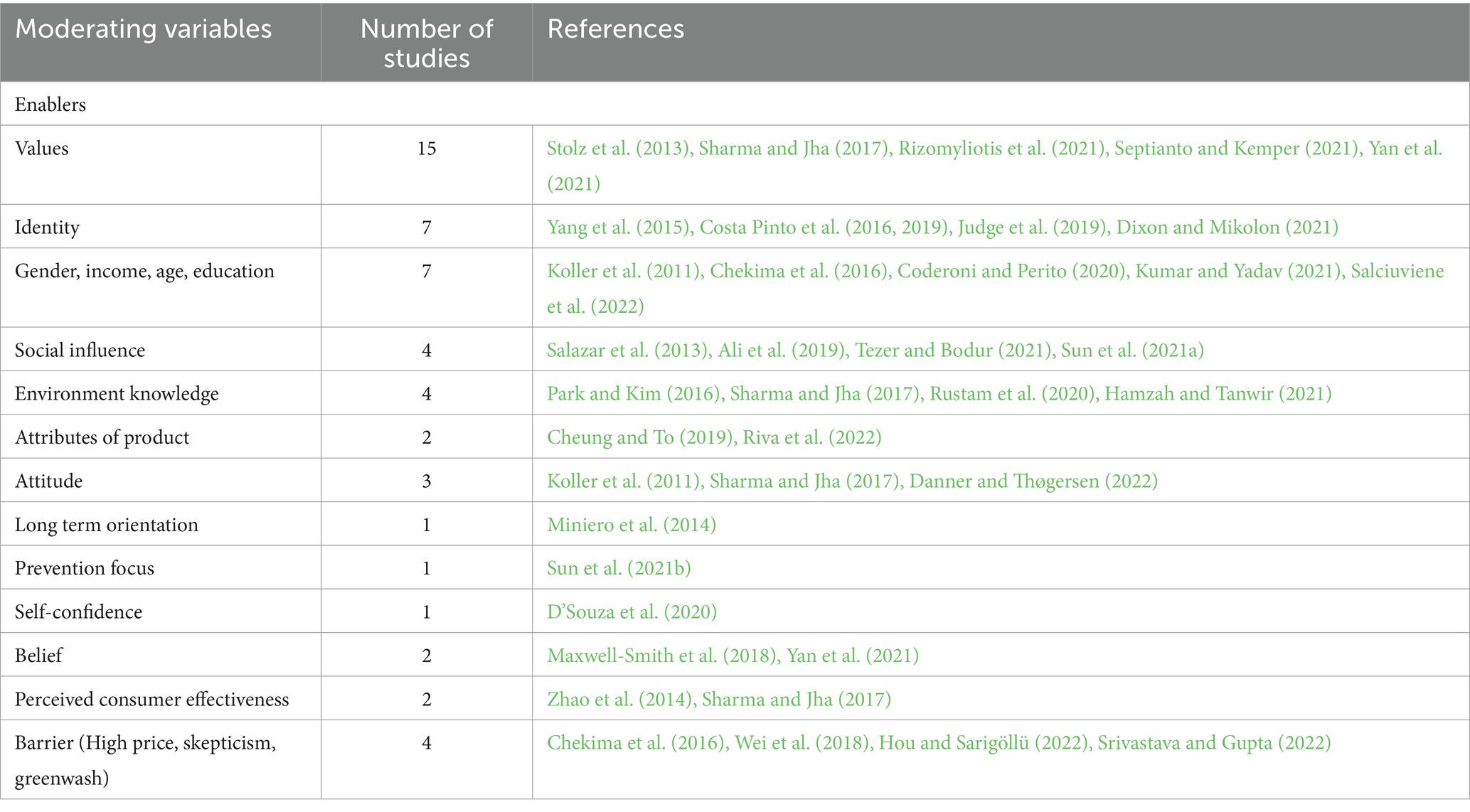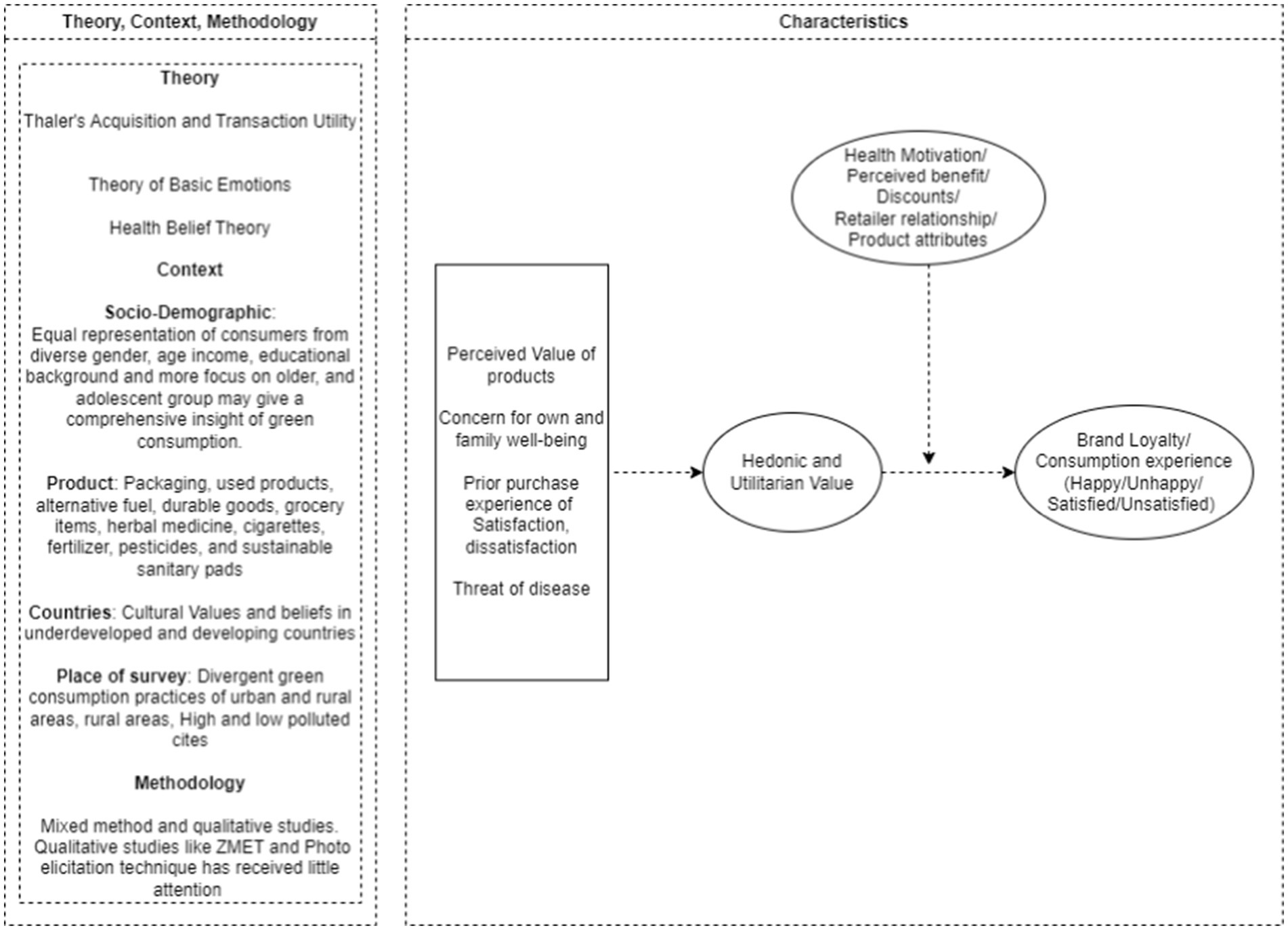- Institute of Rural Management Anand, Gujrat, India
Introduction: Over the past decade, there has been growing research into the consumption of environmentally friendly products, driven by heightened environmental concerns and a shift towards more conscientious purchasing. Despite generally favorable attitudes towards green products, actual purchase rates remain low, creating a gap between attitudes and behavior. Existing studies present a mixed picture, with some findings conflicting and others consistent, underscoring the need for a thorough review of the literature on green consumption. This study aims to assess the existing literature on green consumption by examining major theoretical frameworks, socio-demographic characteristics, and geographic contexts of green consumers, as well as the most studied product categories. It also explores the antecedents and consequences of green product purchases, the mediators and moderators affecting these relationships, and the methodologies used by scholars in this field.
Methods: Using the PRISMA (Preferred Reporting Items for Systematic Reviews and Meta-Analysis) and TCCM (Theory-Context-Characteristics-Methodology) frameworks, the study systematically searches, selects, and synthesizes relevant data, providing a comprehensive mapping of research. This approach allows for a critical evaluation of theoretical foundations, diverse contexts of green consumption, key variables, and the methodologies employed in previous studies.
Results and discussion: The findings indicate that social psychology theories are prevalent in green consumption research and highlight the need to expand the field’s theoretical base. By identifying underexplored product categories, socio-demographic groups, and geographic regions, marketers can more effectively target new segments. The review also identifies major enablers and barriers to green product purchases and suggests further investigation into underexplored variables to develop more effective marketing strategies. To advance the study of consumer behavior regarding green products, the review advocates for the use of mixed-method and qualitative approaches. This comprehensive approach is essential for gaining a deeper understanding of consumer behavior and improving strategies to promote green purchasing and enhance market penetration.
1 Introduction
Green consumption refers to the use of products and services that meet basic needs while minimizing harmful environmental impacts, ensuring that future generations can meet their own needs without compromise (United Nations, 1987; Ministry of Environment Norway, 1995). The environmental impact of unsustainable production and consumption habits, combined with the unequal distribution of resources among consumers, necessitates a shift to green consumption (Peattie and Collins, 2009). Green consumption involves using products and services that meet basic needs while minimizing harmful environmental impacts (Ministry of Environment Norway, 1995) However, the concept of green consumption is contentious, as the term “green” connotes the preservation of natural resources, whereas “consumption” is typically associated with their depletion or degradation (Peattie, 2010). Typically, when consumption is discussed, it is in the context of purchasing (Peattie and Collins, 2009). Green products are predominantly purchased by highly educated, young, female consumers with high family incomes (Lazaric et al., 2020; Severo et al., 2021) and good environmental knowledge (Testa et al., 2019). These consumers tend to prioritize social and environmental well-being (Stolz et al., 2013) and exhibit a positive attitude towards eco-friendly products (Laureti and Benedetti, 2018). Nevertheless, many users perceive green products as expensive (Pagiaslis and Krontalis, 2014; Echegaray and Hansstein, 2017), posing a significant barrier to adoption by price-sensitive consumers Wang et al. (2021).
Numerous studies have shown that consumers generally hold a positive attitude toward green products, but their actual purchase remains low (Johnstone and Tan, 2015; Duong, 2022). This inconsistency is referred to as the attitude-behavior gap (Park and Lin, 2020), intention-behavior gap, or green gap (Nguyen et al., 2019). Consequently, the gap poses challenges for the marketing and adoption of green products among a significant portion of the population. Extensive research has identified several drivers of green purchase behavior, such as values (Stolz et al., 2013; Dangelico et al., 2021), attitude (Testa et al., 2019; Nguyen and Nguyen, 2021) subjective norm (Lee et al., 2015; Frommeyer et al., 2022), and others. Various theories and antecedents have been employed to assess green purchase behavior across diverse contexts. However, these studies have produced contradictory findings. For instance, Becker-Leifhold (2018) discovered that egoistic values motivate consumers’ green purchase behavior while Septianto and Kemper (2021) found that altruistic value motivates consumers’ green purchase behavior. Variability has also been observed within different age groups of consumers. For instance, Islam et al. (2022) found that young consumers are more involved in green purchases, whereas Carrero et al. (2016) reported that older consumers are more involved in green purchases. Additionally, the findings of studies exhibit inconsistency across different product categories. For instance, Ali et al. (2019) concluded that egoistic consumers are more involved in the purchase of eco-friendly cars, whereas Thøgersen et al. (2016) suggested that altruistic consumers are more involved in the purchase of organic food. Considering the wide array of interpretations found in these diverse studies, our objective is to identify the primary drivers and barriers influencing the purchase of green products. The review shall prove beneficial for marketers and researchers in bridging the green gap and effectively targeting their products toward specific segments of the population.
Numerous review papers have been published on the subject; however, the number of analyzed papers and study durations remains limited. For instance, Wijekoon and Sabri (2021) conducted a six-year review to investigate the intention and behavioral drivers of green purchasing, while Testa et al. (2021) focused exclusively on papers to understand drivers of green consumption. Notably, the review excluded experimental and qualitative studies as well as literature centered on organic food. Furthermore, ElHaffar et al. (2020) narrowed their focus to papers with a core green attitude and behavior gap, excluding those addressing reasons and barriers to green behavior. Finally, the study conducted by Sharma K. et al. (2022) analyzed 151 papers to study the intention behavior gap in the purchase of green products. The study lacks a comprehensive analysis of the theories used in the existing literature. The research also omits the consideration of socio-demographic characteristics and has majorly focused on papers with green purchase intention and green purchase behavior potentially limiting insights into the phenomenon under investigation. The present review provides a systematic consolidation of 207 articles focusing on the buying behavior of green consumers from 1993 to 2023. The study uses the Theory-Context-Characteristics-Methodology (TCCM) review framework by Paul and Rosado-Serrano (2019). Given the existing limitations in the literature on green consumption, we aim to address several critical research questions. Specifically, the review focuses on the purchase behavior of green products and seeks to answer the following question:
RQ1: What are the major theoretical frameworks used in the purchase of green products?
RQ2: What are the socio-demographic characteristics and geographic contexts of green consumers, and which product categories have been mostly researched in this context?
RQ3: What are the antecedents and consequences involved in the purchase of green products, and what are the mediators and moderators used in determining the relationship between antecedents and consequences?
RQ4: What methods have been applied by existing scholars to study the purchase of green products?
This study makes several significant contributions to the literature on green consumption. Existing literature on green consumption has predominantly surveyed young, educated, urban, and women consumers, leading to a skewed representation of the sample population and limited variation in the results. To address these gaps, the paper recommends future scholars to incorporate economic theories, theory of basic emotion, and health belief theory in their research. Equal representation of samples from diverse genders, income groups, and educational backgrounds could provide more comprehensive insights into the topic. Furthermore, conducting studies across various product categories will help to map which green products are motivated by specific values. Additionally, exploring rural areas, underdeveloped, and developing countries will assist marketers in tailoring their strategies to target these segments of the population effectively. The subsequent sections of this paper are organized as follows. Section 2 provides an overview of the research methodology applied in the research. Specifically, it delineates the steps involved in the review process, including search strategy, selection criteria, data extraction, and data synthesis. Section 3 provides a summary of the literature review. Section 4 scrutinizes prior studies using the Theory-context-characteristics-methodology (TCCM) framework. Section 5 delineates potential research gaps and future research directions in this field. Finally, Section 6 offers concluding remarks, contribution, theory-based agenda for future research, and limitations and future research avenues.
2 Research methodology
Following the systematic reviews undertaken by Rosado-Serrano et al. (2018) and Roy Bhattacharjee et al. (2022), we gather the data for this research from Scopus. Scopus and Web of Science are the most popular databases for finding quality journals because of their large collection of academic articles from interdisciplinary domains. Scopus has a wider range of subject areas than the Web of Science, so researchers can better find journals relevant to their interests. Scopus contains more publications than any other database in the fields of Social Sciences, Arts, and Management (Paul et al., 2021).
In the first phase of data collection, we conducted a keyword search in the Scopus database using “green consumption” OR “sustainable consumption” OR “eco-friendly product” OR “green consum*” OR “green purchase.” The keywords were searched in the title, abstract, and keywords field under Business, Management, and Accounting categories. The inclusion criteria of this research comprise peer-reviewed academic journals from 1993 to 2023. The period 1993–2023 was chosen because the first article (Lai, 1993) on green consumption was published in 1993. By 2000, only three articles had been published. As shown in Figure 1, the majority (87% of all articles) were published after 2010. The sample was limited to journal articles and excluded book chapters, conference papers, editorials, notes, and short surveys as suggested by (Keupp and Gassmann, 2009). The initial search yielded 1,389 peer-reviewed journal articles. Figure 2 shows the process used to obtain the final journal articles, including the data collection and filtering stages.
In the next phase of data filtration, the study included articles with A and A* ratings from the Australian Business Deans Council Journal ranking list (ABDC ranking) and articles with 4* and 4 ratings from the Chartered Association of Business Schools (CABS ranking list). The selection of high-quality journals was predicated on two reasons, first, the research published in these journals is likely to contain ideas that are carefully examined, thoroughly evaluated, and expanded upon in future studies, second, these journals serve as scholarly evidence and have significant impact on the field (Podsakoff et al., 2005; Sharma N. et al., 2022). The ABDC JQL and the CABS AJG journal rankings are chosen because they are the most popular and reliable sources of journal rankings in the management discipline (Paul and Criado, 2020; Paul et al., 2021). For the final selection, we read the abstracts and titles of the remaining articles and discarded those that were not focused on the buying behavior of green products. The exhaustive research process resulted in a final subset of 207 articles focusing on the buying behavior of consumer.
The study analyzed 207 articles using the Theory-Context-Characteristics-Methods (TCCM) framework. This framework helps examine the theories, contexts, variables, and methodologies employed in existing literature. From this analysis, a conceptual model was developed, highlighting the major variables commonly used in these studies and suggesting additional variables for future research. The paper also identifies research gaps in the current studies, categorized by theory, context, characteristics, and methods according to the TCCM framework. Following the discussion on research gaps, the paper concludes by outlining the study’s conclusions, contributions, theory-based agenda for future research, and limitations and future research avenues.
3 Literature review
The first definition of green consumption was given in the Brundtland Report (United Nations, 1987) as consumption that meets the needs of the present without compromising the ability of future generations. Since, the first definition, many definitions of green consumption have emerged. Ministry of Environment Norway (1995), defined green consumption as consumption that involves using products and services that meet basic needs while minimizing harmful environmental impacts. According to Dolan (2002), green consumption is consumption that seeks to present a solution to address the ecological problems associated with industrial economic production. Likewise, Mont and Plepys (2008), defined green consumption as the type of consumption that not only includes buying environmentally sound products and services but also finding happiness in less material ways of living. Later, Lee et al. (2015), defined green consumption as being environmentally conscious through the consumption (purchase and use) of greener or environmentally friendly products and following anti-consumption and disposal practices of rejecting, reusing, reducing, and recycling. Furthermore, Watkins et al. (2016), defined green consumption as consumption that includes behaviors that extend consideration beyond an individual’s green product choices and include value-based behaviors such as vegetarianism, energy conservation, and transportation choices.
However, the concept of green consumption is problematic as green suggests environmental conservation while consumption implies the use of resources (Peattie, 2010). Consumption is the rational satisfaction of needs to maximize the utility (Prothero and Connolly, 2003). It is influenced by various factors and can be seen as an economic, physical, and social process. It is shaped by individual characteristics, such as nature, circumstances, and psychology, as well as societal aspects, including geography, culture, laws, politics, and infrastructure (Peattie, 2010).
The literature on green consumption offers valuable insights about eco-friendly products. Eco-friendly products are environmentally friendly products that are designed to benefit the environment throughout their entire lifecycle, including considerations of raw materials and manufacturing processes (Sun and Yoon, 2022). These eco-friendly products are priced higher and are generally purchased by high-income and well-educated individuals (Laureti and Benedetti, 2018; Lazaric et al., 2020; Kumar and Yadav, 2021). Women and young consumers are more likely to purchase eco-friendly products compared to men (Bulut et al., 2017; Laureti and Benedetti, 2018; Iran et al., 2019; Lazaric et al., 2020; Borau et al., 2021; Yan et al., 2021). Consumers with a green self-identity understand the reciprocal relationship between their activities and the environment (Lin and Niu, 2018; Sharma et al., 2020). This awareness fosters a sense of environmental responsibility (Chen, 2020) and motivates values related to the concern for others and the environment (Kadic-Maglajlic et al., 2019). This eco-friendly attitude influences their purchasing decision for eco-friendly products (Jacobs et al., 2018).
Family members and peer influence significantly motivate individuals to purchase eco-friendly products (Bhardwaj et al., 2023). Quality is also a guiding factor. High-quality eco-friendly products build trust (D’Souza et al., 2020). Credible production processes further motivate consumers (Ahmad and Zhang, 2020), while ecolabels enhance purchase intention by indicating minimal environmental impact (Chekima et al., 2016).
Some barriers have also been recognized which hinder the purchase of eco-friendly products. High prices deter consumers who prefer to allocate their budget to multiple ordinary products rather than a few expensive ones (Sun et al., 2021). Skepticism towards the environmental claims and greenwashing negatively impacts purchase intention, as misleading claims undermine trust (Mostafa, 2006; Ahmad and Zhang, 2020).
Sustainable behavior refers to decision made to benefit the environment or minimize the negative effect on it (Trudel, 2019). These behaviors are called by many other names like pro-environment behavior, environment-friendly behavior, green behavior, sustainable behavior, responsible behavior, and conservation behavior (Osbaldiston and Schott, 2012). Sustainable behavior includes a wide range of activities like energy conservation, waste reduction, recycling, green purchase, sustainable transportation, water conservation (Kollmuss and Agyeman, 2002).
The existing literature identifies numerous enablers and barriers influencing the purchase of eco-friendly products, yet none offers a comprehensive analysis of the contradictory findings regarding these factors. This research aims to provide a holistic review of existing studies, synthesizing their findings to identify major factors that influence both the purchase behavior and purchase intentions of green products.
4 Analysis of the existing literature based on the theory-context-characteristics-methods framework
The present study undertakes a systematic review of the extant literature on green consumption by employing the theory-context-characteristics-methods (TCCM) framework proposed by Paul and Rosado-Serrano (2019). TCCM is a comprehensive mapping of research, allowing for critical evaluation of theoretical foundations, diverse contexts of green consumption, key variables within the domain and their relationships, and the methodologies employed in prior studies (Ghorbani et al., 2022). The rationale for adopting the TCCM framework stems from its ability to measure both theoretical and empirical aspects of a research domain. As such, this approach effectively overcomes the limitations of more narrowly focused reviews, such as domain-based reviews (Canabal and White, 2008), theory-based reviews (Gilal et al., 2019), method-based reviews (Voorhees et al., 2016), and bibliometric reviews (Randhawa et al., 2016).
4.1 TCCM: “methods”
This section of the study presents an assessment of the research design and analytical techniques employed by the existing studies to evaluate key relationships. The predominant quantitative method utilized across the studies is surveys accounting for 143 studies. Experiments are the second most commonly used method (37 studies), followed by mixed method (15 studies), and qualitative (14 studies). Table 1 gives a summary of the approaches used to collect the data in Green Consumption research.
The predominant data analysis technique employed in green consumption research is structural equation modeling (SEM), utilized in 99 studies. Other commonly employed techniques include regression (33 studies), Analysis of variance (ANOVA) (29 studies), and logistic regression (10 studies). ANOVA is frequently employed in experiments to compare different groups, as seen in 29 studies, with 20 of them specifically based on experiments. Additional analytical techniques employed in green consumption literature include the multilevel random effect model (Laureti and Benedetti, 2018), MANOVA (Hoffmann and Schlicht, 2013), correlation (Olson, 2022), welch brown Forsythe (Shiel et al., 2020), probit model (Olson, 2022), hierarchical Bayesian estimation model (Heinzle and Wüstenhagen, 2012), wald test (van Tonder et al., 2020), mann whitney U test (Torres-Ruiz et al., 2018), conjoint analysis (Heinzle and Wüstenhagen, 2012), fuzzy cognitive map (De-Magistris and Gracia, 2016), latent class modeling (De-Magistris and Gracia, 2016), FIMIX PLS (Bulut et al., 2017), kruskal wallis test (Eberhart and Naderer, 2017), K means clustering (Eberhart and Naderer, 2017), and latent Dirichlet allocation algorithm (Danner and Thøgersen, 2022). Table 2 gives a brief description of the techniques used to collect the data in green consumption research.
The current state of research on green consumption is characterized by a dearth of qualitative studies. Nonetheless, the few qualitative studies that have been conducted in this field have employed a range of methodological techniques such as case study, laddering, ethnographic study, focus group discussion, in-depth interviews, photo-elicitation techniques, and observing through eye tracking glasses.
4.2 TCCM: “Theory”
In recent years, the exploration of green consumption has captured significant interest, delving into a range of theoretical perspectives to illuminate its consequential impacts. Researchers investigating green consumption behaviors have commonly integrated theoretical frameworks rooted in social psychology. These frameworks help uncover the diverse factors that drive individuals towards environmentally conscious buying decisions. This paper aims to delve into the extensively studied theories that have been employed in green consumption literature.
4.2.1 Theory of planned behavior and theory of reasoned action
The theory of planned behavior (TPB) is the most prominent theoretical framework applied to understand green consumption behavior (40 studies). TPB is an extension of the Theory of Reasoned Action (TRA) by the addition of perceived behavioral control Hill et al. (1977). TPB postulates three independent determinants of intention. First is attitude, which refers to the degree of favorable or unfavorable evaluation of behavior. The second is the subjective norm, which refers to the perceived social pressure to perform or not to perform the behavior. The third antecedent is perceived behavioral control (PBC), which refers to the perceived ease or difficulty of performing the behavior (Ajzen, 1991). PBC, along with behavioral intention is used to directly predict behavioral achievement. The research focused on green consumption behavior has employed the TPB and TRA by extending them, using them exclusively, and integrating them with other theories. Table 3 below presents a classification of studies that have utilized the TPB theory. The table reveals that a majority of these studies have extended the TPB theory by introducing additional variables.
4.2.2 Cognitive theories
Many scholars in the field of green consumption have examined how consumers learn and make purchase decisions using diverse cognitive models. Table 4 summarises the numerous theoretical frameworks that investigate the influence of cognitive processes on consumer behavior. The results indicate that despite the utilization of a range of cognitive theories in this domain, their combined impact encompasses a mere 9.5% of the entire pool of scrutinized articles. This underscores the need for a more cohesive integration and enhanced application of these frameworks in forthcoming research endeavors.
4.2.3 Value theories
This section provides an overview of the value theories employed in green consumption literature. Table 5 lists the value theories along with the number of articles and the references that have used these theories in green consumption literature. The table highlights the role of value systems in shaping consumer behavior and their potential impact on environmental sustainability. The table shows that the collective contribution of all the value theories is good, however, their individual contribution is less.
4.2.4 Identity theories
Identity theories suggest that an individual’s self-concept influences their consumption behavior. Empirical studies have employed diverse identity-based frameworks to explore how self-identity connects with the purchase of green products. Table 6 summarizes the identity theories applied in the green consumption literature, along with the number of articles that have used these theories. The table highlights that the cumulative effect of various identity theories is low, accounting for only 7 studies.
4.2.5 Motivation theories
Various theoretical frameworks have been utilized to elucidate the motivations behind consumers’ engagement in sustainable consumption practices. In summary, Table 7 provides an overview of the motivation theories that have been utilized in studies of green consumption, along with the number of articles that have employed these theories. The analysis of relevant literature shows that the collective contribution of motivation theories in green consumption research is significant, accounting for 27 studies. However, it is noteworthy that the individual theories categorized under the umbrella of motivation theories have received relatively little attention. This finding highlights the potential for further exploration and integration of specific motivational theories.
4.2.6 Other theories
We explored various other theories that have been employed to understand the factors influencing green consumption behavior. Table 8 provides an overview of the other theories employed in the literature and the number of articles that have considered them. The table elucidates the comparatively diminished contribution of alternative theories within the domain of green consumption literature thereby emphasizing the imperative for subsequent scholars to devote additional scrutiny and contemplation towards this aspect in their forthcoming investigations.
4.3 TCCM: “Context”
In this study, a comprehensive analysis was conducted to explore the socio-demographic characteristics, products, countries, and places of the surveyed population. The inclusion of sociodemographic characteristics was deemed crucial given their demonstrated influence on consumer behavior (Getzner and Grabner-Kräuter, 2004). Notably, a combination of psychographics and socio-demographic characteristics was found to yield superior insights for green segmentation (Patel et al., 2017).
4.3.1 Gender
According to Borau et al. (2021), there exists a prevalent perception among consumers that associates green products with feminine traits. This gendered association has been identified as a deterrent for male consumers, resulting in a lack of engagement in the purchase of green products. In support of this notion, a comprehensive review of the literature on green consumption reveals that women are more involved in the purchase of green products. Specifically, of the 29 studies included in this analysis, the majority (19 studies) (Liobikienė et al., 2017; Feil et al., 2020; Borau et al., 2021; Kumar and Yadav, 2021; Pegan et al., 2023) have reported a greater level of involvement in green purchases among women, while 5 studies have reported higher engagement among men (Mostafa, 2007b; Jansson et al., 2017; Coderoni and Perito, 2020; Duong, 2022; Salciuviene et al., 2022). These findings suggest the importance of recognizing gender-based perceptions and stereotypes in shaping consumer behavior toward sustainable products.
4.3.2 Age group
The current study aims to offer a comprehensive overview of participants’ age demographics within green consumption literature. Through an extensive literature review, we identified the age ranges of individuals studied in the context of green consumption. Our findings highlight a prevailing emphasis on young participants aged 18 to 35 years, accounting for 90 studies. Some studies have explored middle-aged consumers, and a smaller number have investigated older consumer groups aged 50 years and above. Additionally, only two studies examined adolescents below 18 years (Lee, 2011; Geng et al., 2017).
An in-depth literature analysis of the findings of the existing literature suggests a high involvement of young people (18–35 years) and students in green product consumption. This is supported by 8 of 12 studies that focused on age demographics in green consumption literature. However, 5 studies indicated older individuals favor the purchase of green products. In a broader context, prevailing literature leans towards examining younger participants, notably students, in purchasing green products. Expanding research into various age cohorts for green purchases could augment comprehension and contribute to the formulation of green consumption strategies.
4.3.3 Income
In green consumption, a notable proportion of studies have focused on investigating the influence of income on the purchase of environmentally sustainable products (Johnstone and Tan, 2015; Carrero et al., 2016; Jansson et al., 2017; Carrión Bósquez and Arias-Bolzmann, 2022). A total of 15 studies have tackled this subject matter. The majority of these studies, specifically 11 out of the 15, have indicated that green products are commonly regarded as costly, rendering them primarily attainable by affluent consumers. This implies that the perception of high prices could serve as a barrier to the adoption of green consumption practices among individuals with limited financial means.
4.3.4 Education
In the context of green consumption, many studies have focused on participants’ education. 105 studies included college-educated participants in their research, while only 12 involved high school graduates or higher. Some studies did not reveal education levels. Overall, these findings imply that higher education links to more eco-friendly consumption. None of the existing research shows greater green interest among lower-educated individuals. This highlights the role of high education in shaping consumer behavior for eco-conscious practices.
4.3.5 Products
In the domain of green consumption, a majority of studies (99) have not focused on specific product categories. Our findings reveal that among the remaining studies, organic foods are the predominant product category (25; Paul and Rana, 2012; Khan et al., 2023), followed by apparel (15; Wei et al., 2018; Cairns et al., 2022), electric/alternative fuel vehicles (9; Pagiaslis and Krontalis, 2014; Ní Choisdealbha et al., 2020), packaging (4; Trivedi et al., 2018; Kautish et al., 2022), and others (55). Research outcomes in green consumption vary based on these product categories. Given that a significant portion of research publications in this area emphasize the role of values as motivators for green product purchases, our study aims to assess metrics across major product categories used in green consumption. Regarding organic food, six studies show that individuals who prioritize both altruistic and egoistic values are more involved in purchasing organic food (Paul and Rana, 2012; Dorce et al., 2021; Septianto and Kemper, 2021; Dong et al., 2022; Lavuri, 2022; Mazhar et al., 2022), four studies indicate that consumers who prioritize altruistic values are more engaged in buying organic food (Thøgersen et al., 2016; Nosi et al., 2020; Cao et al., 2021; Lavuri, 2022), while two studies emphasize that those who prioritize egoistic values (Basha and Lal, 2019; Singh and Verma, 2017) are more involved in the purchasing organic food. Altruistic values indicate a greater concern for others’ welfare over personal gain while egoistic values emphasize more on personal pleasure. Two studies show that people with altruistic values have a strong propensity for purchasing environmentally friendly packaging (Testa et al., 2020; Koch et al., 2022). For electric or alternative fuel vehicles, three studies indicate that consumers who prioritize altruistic values are more involved in their purchase (Koller et al., 2011; Pagiaslis and Krontalis, 2014; Hamzah and Tanwir, 2021), while two studies show that those with egoistic values are more involved in buying electric vehicles (Dong et al., 2018; Ali et al., 2019). Regarding sustainable clothing, three studies (Wei et al., 2018; Park and Lin, 2020; Rausch and Kopplin, 2021) indicate that consumers with altruistic values are involved in the purchase, while three studies (Becker-Leifhold, 2018; Jacobs et al., 2018; Iran et al., 2019) show that consumers with egoistic values are involved in purchasing sustainable clothes.
4.3.6 Countries
The exploration of green consumption literature has garnered considerable research interest, primarily within developed countries (133 studies) among the total empirical investigations. A substantial share of the total empirical studies is attributed to developing countries (62 studies), whereas underdeveloped nations have contributed comparatively fewer studies, accounting for only 5 studies. A comprehensive overview of studies conducted across different countries is provided in Table 9. It is worth highlighting that 18 studies were carried out in multiple countries. For instance, Shiel et al. (2020), examined sustainable consumer behavior in England and Portugal. Van Tonder et al. (2020), investigated the green consumption behavior of consumers in the USA and South Korea. Stolz and Bautista (2015) explored sustainable consumption patterns in Germany and Spain, (Ganglmair-Wooliscroft and Wooliscroft, 2022) conducted a study in Austria and New Zealand and Kadic-Maglajlic et al. (2019) examined sustainable consumption behavior in Croatia and Slovenia.
There is a paucity of research on green consumption in rural settings, except for a study conducted by Wang et al. (2014). Most studies have primarily focused on urban areas, particularly looking at individuals with higher education and higher income levels.
4.4 TCCM: “Characteristics”
Green consumption research broadly examines the factors that enable or hinder the acquisition of environmentally friendly products. Scholarly investigations have explored a range of consumer psychographic variables that impact their inclination toward the purchase of green products. We have grouped these variables based on their roles in the particular study, with a clear differentiation between independent, dependent, mediating, and moderating variables. Furthermore, within each category of variables, we have made a further distinction between those that act as enablers and those that act as barriers to the purchase of green products.
4.4.1 Independent variables
The analysis of independent variables (191 studies) shows that the bulk of research has employed independent variables.
The majority of studies support the idea that people with values related to concern for others such as altruism (Yarimoglu and Binboga, 2019), biospheric (Mishra et al., 2022), collectivism (Yang et al., 2015), self-transcendence (Jacobs et al., 2018), universalism (Eberhart and Naderer, 2017), Indian values (Sharma and Jha, 2017) are more involved in green consumption, while some studies are also of the view that values related to concern for self, like egoistic value (Becker-Leifhold, 2018), and individualism (Lu et al., 2015), are also linked with green consumption behavior. People who care more about the environment (Leary et al., 2014), have high personal norms (Moser, 2015), possess environmental knowledge (Stolz et al., 2013), and are concerned about their social salience from their peers, family members, and neighbors (Johansson et al., 2020), possess a favorable or pro-social attitude (Bailey et al., 2016) towards the green product. Such people believe that their actions can bring about a significant change in the environment (Chen, 2020; Park and Lin, 2020). Factors like time, inconvenience (Hume, 2010), unavailability (Mishra et al., 2022), institutional pressure (Roxas and Marte, 2022), skepticism (Mostafa, 2006), price (Marde and Verite-Masserot, 2018), greenwash (Testa et al., 2020), distance, and travel time (Ní Choisdealbha et al., 2020) acts as a barrier in the purchase of green products while some contextual factors like environmental pollution (Hoffmann and Schlicht, 2013), pandemic (Severo et al., 2021), technology (Dabbous and Tarhini, 2019) encourages its consumption.
Various factors motivate consumers toward sustainable consumption. These factors include self-identity (Chen, 2020), fashion involvement and status consumption (Becker-Leifhold, 2018), trends (Joshi et al., 2021), health benefits (Feil et al., 2020), consumer self-confidence (D’Souza et al., 2020), emotional attachment to product and nature (Hou et al., 2020; van Tonder et al., 2020), autonomy, affiliation, and control of the product (Dong et al., 2018), feeling of guilt due to unsustainable consumption (Antonetti and Maklan, 2014), long term orientation (Miniero et al., 2014), man nature orientation (Chekima et al., 2016), low power condition (Yan et al., 2021), and past sustainable behavior (Rowe et al., 2019).
Attributes of a product like its functional value (Dangelico et al., 2021), quality (Li et al., 2016), certification (Thompson et al., 2010), ecolabel (Heinzle and Wüstenhagen, 2012), durability (Sun et al., 2021), exclusivity, authenticity, localism (Jung and Jin, 2022), and brand value (Park and Kim, 2016) encourage consumers in their purchase behavior.
Consumers get information about the benefits of green products from many information channels, like newspapers (Simeone and Scarpato, 2020), media (Lin and Hsu, 2015), social groups (Salazar et al., 2013), and campus advertisements (Jahari et al., 2022). This information creates a positive perception of the benefits of green products (Torres-Ruiz et al., 2018). The perception creates a preference for local and organic food (Li et al., 2016; Simeone and Scarpato, 2020) and used products (Crosno and Cui, 2018). Table 10 summarizes the findings of studies that have examined the impact of enablers of green consumption. Enablers are the factors that facilitate purchase behavior, while barriers are those that hinder purchase behavior (Swinburn et al., 2019). The table delineates the description of the variables, number of studies that have reported a positive/negative/insignificant influence of these variables on green purchase, and the references of the high cited studies that have used these variables. The table highlights that eco-friendly attitudes, values related to the concern for others and the environment, social influence, environmental knowledge, perceived behavioral control, green self-identity, attributes of product, ecolabel, trust, perceived consumer effectiveness, and emotional attachment to product, nature, and brand are the major antecedents in the purchase of green products.
Table 11 summarizes the findings of studies that have examined the impact of barriers on green consumption. The table highlights that high prices, unavailability of the product, skepticism, long distance, time and inconvenience, and greenwash are the major barriers to the purchase of green products.
4.4.2 Dependent variable
The investigation of dependent variables pertaining to green product consumption has been broadly categorized into two categories, namely, (1) intention or behavioral engagements, (2) relationship-based outcomes. A total of 87 studies and 70 studies have been conducted on purchase behavior and purchase intention, respectively. These studies have primarily focused on the customer’s intention to purchase green products (Liang et al., 2019; Kumar and Yadav, 2021), and their actual consumption or purchase behavior (Testa et al., 2019; Duong, 2022). A small proportion of studies (5 studies) have explored relationship-based outcomes such as brand loyalty and brand love (Kumar and Yadav, 2021; Rizomyliotis et al., 2021).
Table 12 provides a concise overview of the dependent variables utilized in the present study. As indicated in the table, the examined dependent variables primarily comprise consumption behavior, purchase behavior, or actual purchase and purchase intention. These variables have been more commonly investigated in green consumption.
4.4.3 Mediating variables
A mediator is a variable that helps to explain the relationship between the predictor and the outcome (Baron and Kenny, 1986). Our analysis reveals that 114 studies have explored the effects of mediating variables. Most of the studies have used environmental attitude (Wu et al., 2016; Le et al., 2019), or behavioral/purchase intention (Duong, 2022) as a mediator variable in their studies.
Several factors influence consumers’ engagement in environmentally responsible consumption activities. Environment concerns (Emekci, 2019), awareness of the consequences of unsustainable consumption (Rezvani et al., 2018), and a sense of responsibility towards the environment prevent consumers from engaging in harmful activities. Additionally, social influence from peers and family members (Biswas and Roy, 2015), personal norms (Roos and Hahn, 2017), and green consumption values (Do Paço et al., 2019) motivate consumers in their purchase decisions.
Consumers are also motivated by various utilitarian and hedonic benefits, such as economic and functional value (Koller et al., 2011), acquisition and transaction utility (Yuan et al., 2022), and positive emotions (Spielmann, 2021) associated with the purchase of green products. Moreover, consumers’ connection with the brand (Lin et al., 2017), face consciousness (Yin et al., 2018), marketplace influence (Kautish et al., 2022), online reviews (Nguyen and Nguyen, 2021), love for nature and material things (Dong et al., 2018, 2020), eco-behavioral goals (Roxas and Marte, 2022), locus of control (Sharma K. et al., 2022), compassion for altruistic claims (Septianto and Kemper, 2021), and pride in past sustainable behavior (Rowe et al., 2019) also impact their willingness to engage in environmentally responsible behaviors.
Consumers experience a “warm glow” consumption experience when purchasing green products (Tezer and Bodur, 2021), resulting in their engagement in pro-environmental activities (Kadic-Maglajlic et al., 2019). Factors such as knowledge about the food supply chain (Dong et al., 2022), the propensity to gather additional information (Testa et al., 2020), transparency in the production process (Kumar et al., 2021), trust in the product and brand (Mezger et al., 2020a), and commitment to the place (Lee et al., 2016) further motivate consumers to engage in the purchase of green products.
As green products are priced higher compared to conventional products, people who are motivated to save (Johansson et al., 2020; Wang et al., 2021) or satiated (Hou et al., 2020) are less involved in green consumption activities. Table 13 gives an overview of the mediating variables used in green consumption research. The table highlights that environmental attitude, purchase intention, subjective norm, and values are the most used mediating variables in most of the existing studies.
4.4.4 Moderating variable
A moderator is a variable that influences the direction or strength of the relationship between an independent variable and a dependent variable (Baron and Kenny, 1986). Based on our analysis of the available literature, it appears that only 62 studies evaluated the moderating effects. Several factors were identified as motivators for consumers to purchase green products including values related to the benefit of others and the environment (Chou et al., 2020; Haj-Salem et al., 2022), high status and fashion consciousness (Park and Kim, 2016; Han et al., 2022), self-concept clarity (Dixon and Mikolon, 2021), young generation (Severo et al., 2021), commitment to belief (Maxwell-Smith et al., 2018), moral emotions (Islam et al., 2022), females, high education, high income (Chekima et al., 2016), materialism (Ali et al., 2019), environment knowledge (Rustam et al., 2020), attributes of product like the quality, functional value, newness (Koller et al., 2011), contextual factors like availability, government intervention (Zhang et al., 2019), long term orientation (Miniero et al., 2014), prevention focus (Sun et al., 2021) and consumer self-confidence (D’Souza et al., 2020) motivate consumers in their purchase of green products. Conversely, high prices (Srivastava and Gupta, 2022), greenwash (Wei et al., 2018), and skepticism (Hou and Sarigöllü, 2022) were found to act as barriers to its purchase. Table 14 gives a summary of the moderating variables used in green consumption. The table highlights that values, identity, and sociodemographic characteristics are the most used moderating variables in green consumption.
A concise representation of the main variables used in research concerning green consumption is depicted in Figure 3. This diagram illustrates the major theories, context, characteristics, and the methodoly that have been used in the existing studies. The characteristics represents the primary independent, mediating, moderating, and dependent variables identified in the literature. It outlines the relationship between the independent and dependent variables, listing the major variables used in existing research. Among the independent variables, enablers exert a positive influence on the dependent variable, whereas barriers have a negative impact. The relationship between independent and dependent variables is mediated by factors such as attitude, purchase intention, subjective norm, values, and trust. Enablers positively influence these mediators, while barriers negatively affect them. The mediators, in turn, positively influence the dependent variable. This relationship is further enhanced by the inclusion of moderator variables.
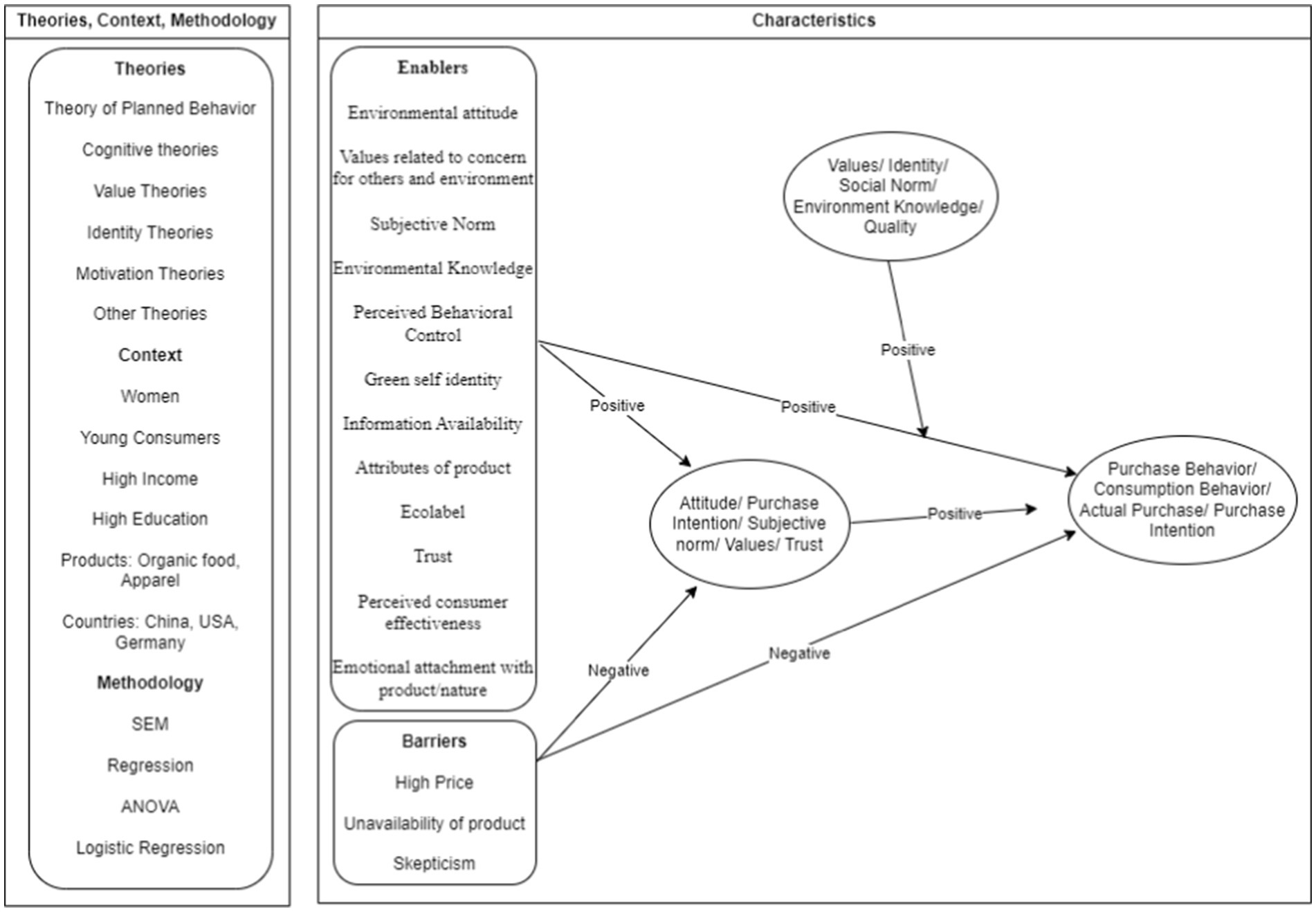
Figure 3. Overview of the existing theories, context, characteristics, and methodology used in the existing studies.
5 Research gaps and future research directions
Based on the TCCM framework (Paul and Rosado-Serrano, 2019), this study has identified several gaps in the current literature regarding green consumption. Research gaps are defined as specific topics or areas where the existing evidence is inadequate, making it difficult to draw definitive conclusions for particular research questions (Wong et al., 2021).
5.1 TCCM: “Theory”
The application of social psychology has dominated the field of green consumption. Economic theories that emphasize the perceived utility of green products have received less attention in this area of research. Therefore, future researchers can use Thaler’s acquisition and transaction utility theory (Thaler, 1985). The utility theory is useful as it postulates that buyers engage in the mental tradeoff between benefits and prices, thereby enhancing their overall evaluation of purchase (Yuan et al., 2022). A few studies have explored moral emotions in the context of green consumption research. However, the role of basic emotions remains insufficiently addressed. Moral emotions pertain to emotional responses that arise in events that stimulate individuals toward action (Kroll and Egan, 2004). They can be categorized into two types: negatively valenced moral emotions, which include shame, guilt, and embarrassment, and positively valenced moral emotions, which include pride, gratitude, and elevation (Tangney et al., 2007). In contrast, basic emotions are the emotions found in most human cultures and species. They are considered to be innate and universal (Ekman, 1992) and can be classified into two types: negative emotions, which include anger, fear, sadness, and shame, and positive emotions, which include contentment, happiness, love, and pride (Laros and Steenkamp, 2005). The influence of basic emotions plays a significant role in the purchasing process, as consumers’ current buying choices are often shaped by the emotional consequences of their prior purchase decisions. Moreover, a substantial number of consumers opt for green products due to health concerns. Non-green products are often associated with potential health risks. However, this aspect remains unexplored in existing literature, offering a promising avenue for future exploration. The Health Belief Theory (HBM) proposed by (Rosenstock, 1974) emerges as a fitting framework. The HBM proposes that an individual’s perception of health threats significantly shapes their health-related behaviors. By adopting this model researchers can delve into how consumer perceptions regarding health risks tied to non-green products impact their purchase choices and consumption behaviors. This study proposes that future researchers focus on the utility theory, moral and basic emotions, and health beliefs as key factors influencing green consumption behavior.
5.2 TCCM: “Context”
In the context of green consumption, the research has identified significant gaps in sociodemographic characteristics, products, countries, and places of the surveyed population. These gaps will help in generating new knowledge, leading to a deeper understanding of the topic (Verbeke, 2005; Roy Bhattacharjee et al., 2022).
5.2.1 Products
The field of green consumption research has witnessed a substantial body of literature that lacks specificity concerning product categories. While some studies have focused on particular product categories (Hamzah and Tanwir, 2021; Septianto and Kemper, 2021), the majority of the literature is broadly concerned with sustainable consumption in general, without delving into the specifics of different products. Notably, among the studies that have targeted particular product categories, organic food, and apparel have emerged as the most frequently studied categories. Future researchers should investigate various product categories to fill the gaps in green consumption research. Areas that have received little attention include packaging, used goods, alternative fuels, durable goods, and daily grocery items like soap, toothpaste, and skincare products. Additionally, certain categories such as herbal medicines, herbal cigarettes, sustainable sanitary alternatives, herbal fertilizers, and pesticides have not yet been explored.
5.2.2 Socio-demographics
The current body of literature on green consumption has focused primarily on millennials, with a particular emphasis on individuals aged between 18 and 35 years (Stolz and Bautista, 2015; Yuan et al., 2022). While some studies have explored the attitudes and behaviors of middle-aged consumers, little attention has been given to older consumer demographics. Additionally, only two studies have investigated the adolescent group (Lee, 2011; Geng et al., 2017). Therefore, there is a significant research gap in understanding the green consumption behavior of the older population and adolescents. Specifically, longitudinal studies are needed to examine the development and changes in green consumption behavior across the lifespan and to identify the factors that influence the adoption and maintenance of sustainable consumption practices of consumers of different age groups.
Despite the existing research on the relationship between green products and income, there is still a gap in understanding how green product purchasing behavior varies across different income groups. Dekhili and Achabou (2013) and Stolz and Bautista (2015), have established that green products are often considered as high-cost items. As a result, individuals with higher incomes are more inclined to purchase them, as suggested by Carrero et al. (2016). Some researchers also suggest that individuals from lower socioeconomic backgrounds purchase green products (Elliott, 2013).
The field of green consumption research has predominantly focused on surveying individuals with college degrees and interviewing college students. This has resulted in a body of literature indicating that highly educated consumers are more likely to purchase green products, as evidenced in studies conducted by (Pagiaslis and Krontalis, 2014) and (Salazar et al., 2013). However, the impact of environmental deterioration is pervasive and has affected individuals from all sections of society (Díaz et al., 2019)
5.2.3 Countries
The examination of green consumption behavior has predominantly occurred in developed nations, with China emerging as a primary contributor to such research among developing countries (Chan, 2001; Cheung and To, 2019). While a limited number of studies have been conducted in India, Pakistan, Bangladesh, and other underdeveloped and developing nations (Kautish et al., 2019; Mazhar et al., 2022), there remains a significant gap in our understanding of green consumption practices in these regions. Furthermore, only a few researchers have explored green consumption behavior across various countries.
5.2.4 Place of surveyed population
Green consumption research has primarily focused on urban consumers, with metropolitan areas receiving the most attention (Dong et al., 2020). There is a dearth of research in the green consumption literature that investigates the rural context, except for one study conducted by (Wang et al., 2014). Furthermore, the impact of pollution in cities has resulted in increased interest in eco-friendly products among consumers (Sun et al., 2019). As such, understanding the divergent green consumption practices of consumers residing in high and low-pollution cities is limited in the existing studies.
This study proposes to fill the gaps in green consumption research by investigating specific product categories that have received little attention, such as packaging, used goods, alternative fuels, durable goods, and daily essentials. Additionally, it aims to explore the green consumption behaviors of various socio-demographic groups, including older adults and adolescents, across different income levels and educational backgrounds. Furthermore, future research can also examine how cultural values and beliefs influence green consumption in underdeveloped and developing countries and investigate the divergent practices of consumers in urban, rural, high-pollution, and low-pollution areas.
5.3 TCCM: “Characteristics”
The examination of the characteristics within the existing literature on green consumption has revealed a notable disparity in the attention afforded to enablers and barriers (Testa et al., 2021). While the former has been the focus of most studies, less attention has been given to the latter. Additionally, research gaps have been identified across independent, mediating, moderating, and dependent variables analyzed in green consumption research.
5.3.1 Independent variables
The identification of the independent variable indicates that the majority of research on green consumption has been centered on the examination of altruistic values like environmental attitudes and values, particularly those that pertain to the care and preservation of the natural environment and its inhabitants, and their effect on consumers’ purchasing behaviors. However, there is a dearth of literature that seeks to comprehend the influence of egoistic values like the perceived usefulness of green products, as evaluated by consumers, the level of concern individuals have for their own well-being and that of their families, and the impact of prior purchase experiences like satisfaction, dissatisfaction, and post-purchase regret on consumers’ future buying decisions. Additionally, the research on green consumption has not given due attention to the potential health-related risks that motivate consumers to choose environmentally friendly products. Some studies have indicated that consumer purchase decisions are more significantly influenced by egoistic values as opposed to altruistic values (Yadav, 2016). Therefore, it is crucial to comprehend the impact of these egoistic factors on consumer purchasing decisions.
5.3.2 Mediating variables
Mediating variables pertaining to attitudes and purchase intentions have been a common focus in the majority of studies in green consumption research. However, there has been relatively less investigation into the potential role of hedonic and utilitarian benefits of the product as mediating variables. The inclusion of hedonic and utilitarian aspects as mediating variables is significant due to the fact that consumers’ purchase decisions are fundamentally influenced by their perception of the product’s value and the overall experience they derive from it (Maehle et al., 2015).
5.3.3 Moderating variables
The use of moderating variables in research has predominantly focused on examining values, identity, and demographic factors. However, there is a notable paucity of studies that have investigated how product attributes, self and family care, brand influence and loyalty, retailer relationships, discounts, end-of-season sales, perceived health benefits, and health motivation may function as moderating variables. The use of moderators helps in providing a more refined understanding of a causal relationship between independent and dependent variables (Wu and Zumbo, 2008).
5.3.4 Dependent variables
The prevailing body of literature on green consumption has primarily focused on investigating green or sustainable consumption behavior, purchase behavior, actual purchase, and purchase intention as dependent variables (Liobikienė et al., 2017; Dhir et al., 2021; Bhardwaj et al., 2023). Despite its crucial significance, the exploration of consumer brand loyalty has been comparatively underrepresented in the literature. Furthermore, there appears to be a notable dearth of research that has delved into the consumption experience of being happy, unhappy, satisfied, or unsatisfied, warranting further investigation in this area.
This study proposes to address the gaps in green consumption research by exploring the influence of egoistic values, such as perceived usefulness and personal well-being, on consumer purchasing decisions. Future research can also investigate the role of hedonic and utilitarian benefits as mediating variables, and how product attributes, brand loyalty, and health motivation function as moderating variables. Additionally, future research can emphasize underrepresented areas like consumer brand loyalty and consumption experience.
5.4 TCCM: “Methods”
The field of green consumption research has been primarily dominated by quantitative studies, with a scarcity of qualitative and mixed-methods research. The predominant analytical tools employed in this field are structural equation modeling (SEM), confirmatory factor analysis (CFA), and regression analysis. In experimental studies, analysis of variance (ANOVA) has been widely utilized to compare the consumption patterns of two groups within the study population. Qualitative studies, on the other hand, have mainly relied on in-depth interviews and focus group discussions as the primary data collection methods. It is worth noting that the underrepresentation of qualitative and mixed-methods studies in green consumption research implies a potential gap in the literature that merits further exploration. Qualitative studies, in particular, are invaluable in providing an in-depth understanding of people’s experiences, yielding much richer information about a phenomenon compared to quantitative research. Quantitative methods, by contrast, can answer only a finite set of questions and offer little room for open-ended exploration (Jackson et al., 2007). Mixed-method research, on the other hand, has the potential to bridge the quantitative and qualitative methodological divide and unify dissimilar areas of the discipline, thus offering a comprehensive understanding of the subject matter (Dunning et al., 2008).
Therefore, it is advisable for forthcoming research to incorporate a greater diversity of methodologies, with a particular emphasis on mixed methods and qualitative research. Some qualitative techniques, such as photo elicitation, Z-MET analysis, and observation through eye-tracking glasses, are also suggested as useful tools for observing and analyzing the behavior of participants in such studies.
6 Conclusion
Green consumption encompasses purchasing, recycling, reduced consumption, ethical consumption, and anti-consumption. Existing studies mainly focus on green purchase intentions and behaviors through the lens of social psychology theories. However, economic theories, moral and basic emotion theories, and the Health Belief Theory have received less attention. Current research predominantly focuses on young, educated, urban, and female consumers, leading to a skewed representation. To gain comprehensive insights, future studies should include underexplored product categories, diverse genders, income groups, educational backgrounds, and populations from rural and developing areas. Additionally, examining egoistic values, hedonic and utilitarian benefits, and underexplored moderating variables such as product attributes, self and family care, brand influence and loyalty, retailer relationships, discounts, end-of-season sales, perceived health benefits, and health motivation motivations will enhance the understanding of green consumption. The field needs more qualitative and mixed-methods research to complement the existing quantitative studies and provide richer insights.
The paper is a significant attempt to synthesize the existing research on green consumption and highlight the research gaps to set future research agendas. As such, future researchers and marketers will benefit from the review in the following ways.
6.1 Theoretical-based agenda for future research
This study makes a significant theoretical contribution by identifying the predominant focus on social psychology theories (Lavuri, 2022; Sun et al., 2022), and highlighting the critical gap left by the limited attention to economic theories (Yuan et al., 2022), moral and basic emotion theories (Liang et al., 2019; Wang et al., 2022), and Health Belief Theory (Alagarsamy and Mehrolia, 2023). Figure 4 summarizes the gaps in current research and proposes directions for future studies. It highlights the need to integrate Thaler’s Acquisition and Transaction Utility theory, Theory of Basic Emotion, and Health Belief theory. Advocating for a multidisciplinary approach underscores the importance of integrating these underutilized theories to provide deeper insights into cost–benefit analyses, ethical considerations, emotional responses, and health-related motivations in green consumption. By encouraging the integration of these diverse theoretical perspectives, this study encourages future research to adopt a more holistic view of green consumption. Additionally, ensuring diverse representation across gender, age, income, education, product categories, countries, and survey locations may reveal new perspectives on green consumption. Utilizing the underexplored variables and employing mixed methods and qualitative studies can also provide a more thorough understanding of the subject.
6.2 Practical contributions
This study offers valuable practical contributions to the field of green consumption by identifying overlooked areas and providing marketers with opportunities to develop eco-friendly products in underexplored categories. By focusing on sustainable packaging, used goods, alternative fuels, durable goods, and daily groceries like soap, toothpaste, and skincare products, as well as herbal medicines, herbal cigarettes, sustainable sanitary alternatives, herbal fertilizers, and pesticides, marketers can cater to environmentally conscious consumers and meet the growing demand for sustainable solutions.
Additionally, the study highlights the need for equal representation of diverse genders, income groups, and educational backgrounds, suggesting a more comprehensive approach to understanding consumer behaviors. Including older and adolescent consumer groups can offer even deeper insights. This can help marketers and policymakers develop more inclusive and effective strategies tailored to various demographic segments, including those in rural and developing areas.
The emphasis on underexplored egoistic values such as perceived usefulness and personal well-being, alongside altruistic values like environmental attitudes, offers a balanced perspective that can enhance marketing campaigns. Companies can leverage this insight to address both environmental benefits and personal advantages of green products, thereby broadening their appeal.
Addressing the high prices, limited availability, and skepticism towards green products can help rebuild consumer trust. By focusing on these issues, businesses can improve their product offerings and communication strategies to better meet consumer expectations.
The study also underscores the importance of exploring hedonic and utilitarian benefits as mediating variables, which can inform product development and marketing strategies to enhance consumer satisfaction and purchase intentions.
Furthermore, by identifying gaps in the examination of moderating variables such as product attributes, brand influence and loyalty, retailer relationships, discounts, perceived health benefits, and health motivation, the study provides a roadmap for future research. This can help businesses better understand the factors that influence green consumption and develop targeted interventions to promote sustainable behaviors.
Finally, the call for more qualitative and mixed-methods research highlights the need for richer, more nuanced insights into green consumption. This can lead to more effective and tailored marketing strategies, ultimately fostering a deeper and more widespread adoption of green products and practices.
6.3 Limitation
This systematic literature review has some limitations. Firstly, it is important to note that the scope of this study was restricted to the subject domain of business, management, and accounting, and did not incorporate articles from other subject areas. Secondly, the study only utilized the Scopus database, whereas there are other literature search resources such as EBSCO, JSTOR, and Google Scholar that may yield additional relevant publications. Thirdly, it is important to acknowledge that green consumption encompasses a wide range of dimensions including purchasing, recycling, reduced consumption, ethical consumption, and anti-consumption. However, this study exclusively focused on the purchasing aspect.
Data availability statement
The original contributions presented in the study are included in the article/supplementary material, further inquiries can be directed to the corresponding author.
Author contributions
M: Writing – original draft.
Funding
The author(s) declare that no financial support was received for the research, authorship, and/or publication of this article.
Acknowledgments
The author would like to acknowledge the use of ChatGPT-4 and Quillbot for their assistance in writing this manuscript. Their support was invaluable in refining the language and enhancing the overall clarity of the text.
Conflict of interest
The author declares that the research was conducted in the absence of any commercial or financial relationships that could be construed as a potential conflict of interest.
Publisher’s note
All claims expressed in this article are solely those of the authors and do not necessarily represent those of their affiliated organizations, or those of the publisher, the editors and the reviewers. Any product that may be evaluated in this article, or claim that may be made by its manufacturer, is not guaranteed or endorsed by the publisher.
References
Ahmad, W., and Zhang, Q. (2020). Green purchase intention: effects of electronic service quality and customer green psychology. J. Clean. Prod. 267:122053. doi: 10.1016/j.jclepro.2020.122053
Ajzen, I. (1991). The theory of planned behavior. Organ. Behav. Hum. Decis. Process. 50, 179–211. doi: 10.1016/0749-5978(91)90020-T
Alagarsamy, S., and Mehrolia, S. (2023). Predicting intention to buy organic food during the Covid-19 pandemic: a multi-group analysis based on the health belief model. J. Int. Food Agribus. Mark. 35, 508–534. doi: 10.1080/08974438.2022.2035881
Ali, A., Xiaoling, G., Ali, A., Sherwani, M., and Muneeb, F. M. (2019). Customer motivations for sustainable consumption: investigating the drivers of purchase behavior for a green-luxury car. Bus. Strateg. Environ. 28, 833–846. doi: 10.1002/bse.2284
Amit Kumar, G. (2021). Framing a model for green buying behavior of Indian consumers: from the lenses of the theory of planned behavior. J. Clean. Prod. 295:126487. doi: 10.1016/j.jclepro.2021.126487
Antonetti, P., and Maklan, S. (2014). Feelings that make a difference: how guilt and pride convince consumers of the effectiveness of sustainable consumption choices. J. Bus. Ethics 124, 117–134. doi: 10.1007/s10551-013-1841-9
Bailey, A. A., Mishra, A., and Tiamiyu, M. F. (2016). GREEN consumption values and Indian consumers’ response to marketing communications. J. Consum. Mark. 33, 562–573. doi: 10.1108/JCM-12-2015-1632
Bandura, A. (1978). The self system in reciprocal determinism. Am. Psychol. 33, 344–358. doi: 10.1037/0003-066X.33.4.344
Bandura, A. (1991). Social cognitive theory of self-regulation. Organ. Behav. Hum. Decis. Process. 50, 248–287. doi: 10.1016/0749-5978(91)90022-L
Bansal, H. S., Taylor, S. F., and James, Y. (2005). Migrating to new service providers: toward a unifying framework of consumers’ switching behaviors. J. Acad. Mark. Sci. 33, 96–115. doi: 10.1177/0092070304267928
Barbarossa, C., and De Pelsmacker, P. (2016). Positive and negative antecedents of purchasing eco-friendly products: a comparison between green and non-green consumers. J. Bus. Ethics 134, 229–247. doi: 10.1007/s10551-014-2425-z
Baron, R. M., and Kenny, D. A. (1986). The moderator–mediator variable distinction in social psychological research: conceptual, strategic, and statistical considerations. J. Pers. Soc. Psychol. 51, 1173–1182. doi: 10.1037/0022-3514.51.6.1173
Basha, M. B., and Lal, D. (2019). Indian consumers’ attitudes towards purchasing organically produced foods: An empirical study. J. Clean. Prod. 215, 99–111. doi: 10.1016/j.jclepro.2018.12.098
Becker-Leifhold, C. V. (2018). The role of values in collaborative fashion consumption - a critical investigation through the lenses of the theory of planned behavior. J. Clean. Prod. 199, 781–791. doi: 10.1016/j.jclepro.2018.06.296
Bhardwaj, S., Sreen, N., Das, M., Chitnis, A., and Kumar, S. (2023). Product specific values and personal values together better explains green purchase. J. Retail. Consum. Serv. 74:103434. doi: 10.1016/j.jretconser.2023.103434
Binder, M., and Blankenberg, A. K. (2017). Green lifestyles and subjective well-being: more about self-image than actual behavior? J. Econ. Behav. Organ. 137, 304–323. doi: 10.1016/j.jebo.2017.03.009
Biswas, A., and Roy, M. (2015). Green products: an exploratory study on the consumer behaviour in emerging economies of the east. J. Clean. Prod. 87, 463–468. doi: 10.1016/j.jclepro.2014.09.075
Black, W. C., and Westbrook, R. A. (1985). A motivation-based shopper typology. J.Retailing 61, 78–103.
Bodner, R., and Prelec, D. (2003). “Self-signaling and diagnostic utility in everyday decision making,” in The psychology of economic decisions. eds. I. Brocas and J. D. Carrillo (Oxford, UK: Oxford University), 1, 105–126.
Borau, S., Elgaaied-Gambier, L., and Barbarossa, C. (2021). The green mate appeal: Men’s pro-environmental consumption is an honest signal of commitment to their partner. Psychol. Mark. 38, 266–285. doi: 10.1002/mar.21321
Brough, A. R., Wilkie, J. E. B., Ma, J., Isaac, M. S., and Gal, D. (2016). The green-feminine stereotype and its effect on sustainable consumption. J. Consum. Res. 43:ucw044. doi: 10.1093/jcr/ucw044
Bulut, Z. A., Kökalan Çımrin, F., and Doğan, O. (2017). Gender, generation and sustainable consumption: exploring the behaviour of consumers from Izmir, Turkey. Int. J. Consum. Stud. 41, 597–604. doi: 10.1111/ijcs.12371
Cairns, H. M., Ritch, E. L., and Bereziat, C. (2022). Think eco, be eco? The tension between attitudes and behaviours of millennial fashion consumers. Int. J. Consum. Stud. 46, 1262–1277. doi: 10.1111/ijcs.12756
Canabal, A., and White, G. O. (2008). Entry mode research: past and future. Int. Bus. Rev. 17, 267–284. doi: 10.1016/j.ibusrev.2008.01.003
Cao, D. Z., Zheng, Y., Liu, C., Yao, X., and Chen, S. (2021). Consumption values, anxiety and organic food purchasing behaviour considering the moderating role of sustainable consumption attitude. Br. Food J. 124, 3540–3562. doi: 10.1108/BFJ-06-2021-0647
Carrero, I., Redondo, R., and Fabra, M. E. (2016). Who is behind the sustainable purchase? The sustainable consumer profile in grocery shopping in Spain. Int. J. Consum. Stud. 40, 643–651. doi: 10.1111/ijcs.12287
Carrión Bósquez, N. G., and Arias-Bolzmann, L. G. (2022). Factors influencing green purchasing inconsistency of Ecuadorian millennials. Br. Food J. 124, 2461–2480. doi: 10.1108/BFJ-05-2021-0558
Chang, H. H., Tsai, S. H., and Huang, C. C. (2019). Sustainable development: the effects of environmental policy disclosure in advertising. Bus. Strateg. Environ. 28, 1497–1506. doi: 10.1002/bse.2325
Chan, R. Y. (2001). Determinants of Chinese consumers’ green purchase behavior. Psychol. Mark. 18, 389–413. doi: 10.1002/mar.1013
Chan, R. Y. K., and Lau, L. B. Y. (2000). Antecedents of green purchases: a survey in China. J. Consum. Mark. 17, 338–357. doi: 10.1108/07363760010335358
Chekima, B. C., Syed Khalid Wafa, S. A. W., Igau, O. A., Chekima, S., and Sondoh, S. L. Jr. (2016). Examining green consumerism motivational drivers: does premium price and demographics matter to green purchasing? J. Clean. Prod. 112, 3436–3450. doi: 10.1016/j.jclepro.2015.09.102
Chen, M. F. (2020). The impacts of perceived moral obligation and sustainability self-identity on sustainability development: a theory of planned behavior purchase intention model of sustainability-labeled coffee and the moderating effect of climate change skepticism. Bus. Strateg. Environ. 29, 2404–2417. doi: 10.1002/bse.2510
Cheung, M. F. Y., and To, W. M. (2019). An extended model of value-attitude-behavior to explain Chinese consumers’ green purchase behavior. J. Retail. Consum. Serv. 50, 145–153. doi: 10.1016/j.jretconser.2019.04.006
Chou, S. F., Horng, J. S., Sam Liu, C. H., and Lin, J. Y. (2020). Identifying the critical factors of customer behavior: an integration perspective of marketing strategy and components of attitudes. J. Retail. Consum. Serv. 55:102113. doi: 10.1016/j.jretconser.2020.102113
Coderoni, S., and Perito, M. A. (2020). Sustainable consumption in the circular economy. An analysis of consumers’ purchase intentions for waste-to-value food. J. Clean. Prod. 252:119870. doi: 10.1016/j.jclepro.2019.119870
Collins, A., and Loftus, E. (1975). A spreading-activation theory of semantic processing. Psychol. Rev. 82, 407–428. doi: 10.1037/0033-295X.82.6.407
Costa Pinto, D., Maurer Herter, M., Rossi, P., Meucci Nique, W., and Borges, A. (2019). Recycling cooperation and buying status: effects of pure and competitive altruism on sustainable behaviors. Eur. J. Mark. 53, 944–971. doi: 10.1108/EJM-09-2017-0557
Costa Pinto, D., Nique, W. M., Maurer Herter, M., and Borges, A. (2016). Green consumers and their identities: How identities change the motivation for green consumption. International J. Consum. Stud. 40, 742–753. doi: 10.1111/ijcs.12282
Crosno, J. L., and Cui, A. P. (2018). Something old, something new: the role of partitioned pricing in consumers’ preference for new versus used products. J. Consum. Mark. 35, 353–365. doi: 10.1108/JCM-02-2017-2091
D’Souza, C., Taghian, M., Hall, J., and Plant, E. (2020). Green consumption: strategic retail considerations and consumer confidence. J. Strateg. Mark. 31, 18–36. doi: 10.1080/0965254X.2020.1863449
Dabbous, A., and Tarhini, A. (2019). Assessing the impact of knowledge and perceived economic benefits on sustainable consumption through the sharing economy: a sociotechnical approach. Technol. Forecast. Soc. Chang. 149:119775. doi: 10.1016/j.techfore.2019.119775
Dai, J., and Sheng, G. (2022). Advertising strategies and sustainable development: the effects of green advertising appeals and subjective busyness on green purchase intention. Bus. Strateg. Environ. 31, 3421–3436. doi: 10.1002/bse.3092
Dangelico, R. M., Nonino, F., and Pompei, A. (2021). Which are the determinants of green purchase behaviour? A study of Italian consumers. Bus. Strateg. Environ. 30, 2600–2620. doi: 10.1002/bse.2766
Danner, H., and Thøgersen, J. (2022). Does online chatter matter for consumer behaviour? A priming experiment on organic food. Int. J. Consum. Stud. 46, 850–869. doi: 10.1111/ijcs.12732
Dekhili, S., and Achabou, M. A. (2013). Price fairness in the case of green products: enterprises’ policies and consumers’ perceptions. Bus. Strateg. Environ. 22, 547–560. doi: 10.1002/bse.1763
De-Magistris, T., and Gracia, A. (2016). Consumers’ willingness-to-pay for sustainable food products: the case of organically and locally grown almonds in Spain. J. Clean. Prod. 118, 97–104. doi: 10.1016/j.jclepro.2016.01.050
De Watanabe, E. A. M., Alfinito, S., Curvelo, I. C. G., and Hamza, K. M. (2020). Perceived value, trust and purchase intention of organic food: a study with Brazilian consumers. Br. Food J. 122, 1070–1184. doi: 10.1108/BFJ-05-2019-0363
Dhir, A., Talwar, S., Sadiq, M., Sakashita, M., and Kaur, P. (2021). Green apparel buying behaviour: a stimulus–organism–behaviour–consequence (SOBC) perspective on sustainability-oriented consumption in Japan. Bus. Strateg. Environ. 30, 3589–3605. doi: 10.1002/bse.2821
Díaz, S., Settele, J., Brondízio, E. S., Ngo, H. T., Agard, J., Arneth, A., et al. (2019). Review summary pervasive human-driven decline of life on earth points to the need for transformative change. doi: 10.1126/science.aaw3100
Dixon, D., and Mikolon, S. (2021). Cents of self: how and when self-signals influence consumer value derived from choices of green products. Int. J. Res. Mark. 38, 365–386. doi: 10.1016/j.ijresmar.2020.08.002
Dolan, P. (2002). The sustainability of “sustainable consumption”. J. Macromark. 22, 170–181. doi: 10.1177/0276146702238220
Dong, X., Jiang, B., Zeng, H., and Kassoh, F. S. (2022). Impact of trust and knowledge in the food chain on motivation-behavior gap in green consumption. J. Retail. Consum. Serv. 66:102955. doi: 10.1016/j.jretconser.2022.102955
Dong, X., Li, H., Liu, S., Cai, C., and Fan, X. (2018). How does material possession love influence sustainable consumption behavior towards the durable products? J. Clean. Prod. 198, 389–400. doi: 10.1016/j.jclepro.2018.07.054
Dong, X., Liu, S., Li, H., Yang, Z., Liang, S., and Deng, N. (2020). Love of nature as a mediator between connectedness to nature and sustainable consumption behavior. J. Clean. Prod. 242:118451. doi: 10.1016/j.jclepro.2019.118451
Do Paço, A., Shiel, C., and Alves, H. (2019). A new model for testing green consumer behaviour. J. Clean. Prod. 207, 998–1006. doi: 10.1016/j.jclepro.2018.10.105
Dorce, L. C., da Silva, M. C., Mauad, J. R. C., de Faria Domingues, C. H., and Borges, J. A. R. (2021). Extending the theory of planned behavior to understand consumer purchase behavior for organic vegetables in Brazil: the role of perceived health benefits, perceived sustainability benefits and perceived price. Food Qual. Prefer. 91:104191. doi: 10.1016/j.foodqual.2021.104191
Drucker, P. F. (2006). Classic Drucker: essential wisdom of Peter Drucker from the pages of Harvard Business Review. Harvard Business Press.
Dunning, H., Williams, A., Abonyi, S., and Crooks, V. (2008). A mixed method approach to quality of life research: a case study approach. Soc. Indic. Res. 85, 145–158. doi: 10.1007/s11205-007-9131-5
Duong, C. D. (2022). Big five personality traits and green consumption: bridging the attitude-intention-behavior gap. Asia Pac. J. Mark. Logist. 34, 1123–1144. doi: 10.1108/APJML-04-2021-0276
Eberhart, A. K., and Naderer, G. (2017). Quantitative and qualitative insights into consumers’ sustainable purchasing behaviour: a segmentation approach based on motives and heuristic cues. J. Mark. Manag. 33, 1149–1169. doi: 10.1080/0267257X.2017.1371204
Echegaray, F., and Hansstein, F. V. (2017). Assessing the intention-behavior gap in electronic waste recycling: the case of Brazil. J. Clean. Prod. 142, 180–190. doi: 10.1016/j.jclepro.2016.05.064
Ekman, P. (1992). An argument for basic emotions. Cognit. Emot. 6, 169–200. doi: 10.1080/02699939208411068
ElHaffar, G., Durif, F., and Dubé, L. (2020). Towards closing the attitude-intention-behavior gap in green consumption: a narrative review of the literature and an overview of future research directions. J. Clean. Prod. 275:122556. doi: 10.1016/j.jclepro.2020.122556
Elliott, R. (2013). The taste for green: the possibilities and dynamics of status differentiation through “green” consumption. Poetics 41, 294–322. doi: 10.1016/j.poetic.2013.03.003
Emekci, S. (2019). Green consumption behaviours of consumers within the scope of TPB. J. Consum. Mark. 36, 410–417. doi: 10.1108/JCM-05-2018-2694
Feil, A. A., Cyrne, C. C., Sindelar, F. C. W., Barden, J. E., and Dalmoro, M. (2020). Profiles of sustainable food consumption: consumer behavior toward organic food in southern region of Brazil. J. Clean. Prod. 258:120690. doi: 10.1016/j.jclepro.2020.120690
Frommeyer, B., Wagner, E., Hossiep, C. R., and Schewe, G. (2022). The utility of intention as a proxy for sustainable buying behavior – a necessary condition analysis. J. Bus. Res. 143, 201–213. doi: 10.1016/j.jbusres.2022.01.041
Fuentes, C. (2014). Managing green complexities: consumers’ strategies and techniques for greener shopping. Int. J. Consum. Stud. 38, 485–492. doi: 10.1111/ijcs.12124
Ganglmair-Wooliscroft, A., and Wooliscroft, B. (2022). An investigation of sustainable consumption behavior systems – exploring personal and socio-structural characteristics in different national contexts. J. Bus. Res. 148, 161–173. doi: 10.1016/j.jbusres.2022.04.049
Geng, D., Liu, J., and Zhu, Q. (2017). Motivating sustainable consumption among Chinese adolescents: an empirical examination. J. Clean. Prod. 141, 315–322. doi: 10.1016/j.jclepro.2016.09.113
Getzner, M., and Grabner-Kräuter, S. (2004). Consumer preferences and marketing strategies for “green shares”: specifics of the Austrian market. Int. J. Bank Mark. 22, 260–278. doi: 10.1108/02652320410542545
Ghazali, E. M., Mutum, D. S., and Ariswibowo, N. (2018). Impact of religious values and habit on an extended green purchase behaviour model. Int. J. Consum. Stud. 42, 639–654. doi: 10.1111/ijcs.12472
Ghorbani, M., Karampela, M., and Tonner, A. (2022). Consumers’ brand personality perceptions in a digital world: a systematic literature review and research agenda. Int. J. Consum. Stud. 46, 1960–1991. doi: 10.1111/ijcs.12791
Gibson, J. J. (1979). The ecological approach to visual perception. Hillsdale, NJ: Lawrence Erlbaum Associates.
Gilal, F. G., Zhang, J., Paul, J., and Gilal, N. G. (2019). The role of self-determination theory in marketing science: an integrative review and agenda for research. Eur. Manag. J. 37, 29–44. doi: 10.1016/j.emj.2018.10.004
Gleim, M. R., Smith, J. S., Andrews, D., and Cronin, J. J. (2013). Against the green: a multi-method examination of the barriers to green consumption. J. Retail. 89, 44–61. doi: 10.1016/j.jretai.2012.10.001
Gustavsen, G. W., and Hegnes, A. W. (2020). Individuals’ personality and consumption of organic food. J. Clean. Prod. 245:118772. doi: 10.1016/j.jclepro.2019.118772
Gutman, J. (1982). A means-end chain model based on consumer categorization processes. J. Mark. 46, 60–72. doi: 10.1177/002224298204600207
Haj-Salem, N., Ishaq, M. I., and Raza, A. (2022). How anticipated pride and guilt influence green consumption in the Middle East: the moderating role of environmental consciousness. J. Retail. Consum. Serv. 68:103062. doi: 10.1016/j.jretconser.2022.103062
Halder, P., Hansen, E. N., Kangas, J., and Laukkanen, T. (2020). How national culture and ethics matter in consumers’ green consumption values. J. Clean. Prod. 265:121754. doi: 10.1016/j.jclepro.2020.121754
Hamzah, M. I., and Tanwir, N. S. (2021). Do pro-environmental factors lead to purchase intention of hybrid vehicles? The moderating effects of environmental knowledge. J. Clean. Prod. 279:123643. doi: 10.1016/j.jclepro.2020.123643
Han, H. (2020). Theory of green purchase behavior (TGPB): a new theory for sustainable consumption of green hotel and green restaurant products. Bus. Strateg. Environ. 29, 2815–2828. doi: 10.1002/bse.2545
Han, M. S., Hampson, D. P., Wang, Y., and Wang, H. (2022). Consumer confidence and green purchase intention: an application of the stimulus-organism-response model. J. Retail. Consum. Serv. 68:103061. doi: 10.1016/j.jretconser.2022.103061
Heinzle, S. L., and Wüstenhagen, R. (2012). Dynamic adjustment of eco-labeling schemes and consumer choice - the revision of the EU energy label as a missed opportunity? Bus. Strateg. Environ. 21, 60–70. doi: 10.1002/bse.722
Hill, R. J., Fishbein, M., and Ajzen, I. (1977). Belief, attitude, intention and behavior: an introduction to theory and research. Contemp. Sociol. 6:244. doi: 10.2307/2065853
Hoffmann, S., and Schlicht, J. (2013). The impact of different types of concernment on the consumption of organic food. Int. J. Consum. Stud. 37, 625–633. doi: 10.1111/ijcs.12044
Homer, P., and Kahle, L. (1988). A structural equation test of the value-attitude-behavior hierarchy. J. Pers. Soc. Psychol. 54, 638–646. doi: 10.1037/0022-3514.54.4.638
Horne, R. E. (2009). Limits to labels: the role of eco-labels in the assessment of product sustainability and routes to sustainable consumption. Int. J. Consum. Stud. 33, 175–182. doi: 10.1111/j.1470-6431.2009.00752.x
Hosta, M., and Zabkar, V. (2021). Antecedents of environmentally and socially responsible sustainable consumer behavior. J. Bus. Ethics 171, 273–293. doi: 10.1007/s10551-019-04416-0
Hou, C., Jo, M. S., and Sarigöllü, E. (2020). Feelings of satiation as a mediator between a product’s perceived value and replacement intentions. J. Clean. Prod. 258:120637. doi: 10.1016/j.jclepro.2020.120637
Hou, C., and Sarigöllü, E. (2022). Is bigger better? How the scale effect influences green purchase intention: the case of washing machine. J. Retail. Consum. Serv. 65:102894. doi: 10.1016/j.jretconser.2021.102894
Hume, M. (2010). Compassion without action: examining the young consumers consumption and attitude to sustainable consumption. J. World Bus. 45, 385–394. doi: 10.1016/j.jwb.2009.08.007
Hunt, S. D., and Vitell, S. J. (1986). A general theory of marketing ethics. J. Macromark. 6, 5–15. doi: 10.1177/027614678600600103
Hur, E. (2020). Rebirth fashion: secondhand clothing consumption values and perceived risks. J. Clean. Prod. 273:122951. doi: 10.1016/j.jclepro.2020.122951
Iran, S., Geiger, S. M., and Schrader, U. (2019). Collaborative fashion consumption – a cross-cultural study between Tehran and Berlin. J. Clean. Prod. 212, 313–323. doi: 10.1016/j.jclepro.2018.11.163
Islam, T., Wang, Y., Ali, A., and Akhtar, N. (2022). Path to sustainable luxury brand consumption: face consciousness, materialism, pride and risk of embarrassment. J. Consum. Mark. 39, 11–28. doi: 10.1108/JCM-09-2020-4099
Jackson, R. L., Drummond, D. K., and Camara, S. (2007). What is qualitative research? Qual. Res. Rep. Commun. 8, 21–28. doi: 10.1080/17459430701617879
Jacobs, K., and Hörisch, J. (2022). The importance of product lifetime labelling for purchase decisions: strategic implications for corporate sustainability based on a conjoint analysis in Germany. Bus. Strateg. Environ. 31, 1275–1291. doi: 10.1002/bse.2954
Jacobs, K., Petersen, L., Hörisch, J., and Battenfeld, D. (2018). Green thinking but thoughtless buying? An empirical extension of the value-attitude-behaviour hierarchy in sustainable clothing. J. Clean. Prod. 203, 1155–1169. doi: 10.1016/j.jclepro.2018.07.320
Jahari, S. A., Hass, A., Idris, I. B., and Joseph, M. (2022). An integrated framework examining sustainable green behavior among young consumers. J. Consum. Mark. 39, 333–344. doi: 10.1108/JCM-04-2021-4593
Jansson, J., Nordlund, A., and Westin, K. (2017). Examining drivers of sustainable consumption: the influence of norms and opinion leadership on electric vehicle adoption in Sweden. J. Clean. Prod. 154, 176–187. doi: 10.1016/j.jclepro.2017.03.186
Joanes, T. (2019). Personal norms in a globalized world: norm-activation processes and reduced clothing consumption. J. Clean. Prod. 212, 941–949. doi: 10.1016/j.jclepro.2018.11.191
Johansson, L. O., Barbopoulos, I., and Olsson, L. E. (2020). Deactivating economic motives in green consumption through social and moral salience. J. Consum. Mark. 37, 247–258. doi: 10.1108/JCM-10-2018-2904
Johnstone, M. L., and Hooper, S. (2016). Social influence and green consumption behaviour: a need for greater government involvement. J. Mark. Manag. 32, 827–855. doi: 10.1080/0267257X.2016.1189955
Johnstone, M. L., and Tan, L. P. (2015). Exploring the gap between consumers’ green rhetoric and purchasing behaviour. J. Bus. Ethics 132, 311–328. doi: 10.1007/s10551-014-2316-3
Jose, J., Biju, M. K., and Vincent, B. (2022). Does consumer attitude influence sustainable buying behavior of branded organic food consumers? The mediating role of green consumption value in predicting the relationship. IUP J. Market. Manag. 21:70.
Joshi, Y., Yadav, R., and Shankar, A. (2021). The interplay of emotional value, trend affinity and past practices in sustainable consumption: an application of theory of reciprocal determinism. J. Strateg. Mark. 1–9. doi: 10.1080/0965254X.2021.1914133
Judge, M., Warren-Myers, G., and Paladino, A. (2019). Using the theory of planned behaviour to predict intentions to purchase sustainable housing. J. Clean. Prod. 215, 259–267. doi: 10.1016/j.jclepro.2019.01.029
Jung, S., and Jin, B. E. (2022). Slow fashion branding: understanding what consumers value most. J. Brand Manag. 29, 1–9. doi: 10.1057/s41262-021-00256-4
Kadic-Maglajlic, S., Arslanagic-Kalajdzic, M., Micevski, M., Dlacic, J., and Zabkar, V. (2019). Being engaged is a good thing: understanding sustainable consumption behavior among young adults. J. Bus. Res. 104, 644–654. doi: 10.1016/j.jbusres.2019.02.040
Kahneman, D., and Tversky, A. (2013). “Prospect theory: An analysis of decision under risk,” in Handbook of the fundamentals of financial decision making: Part I. 99–127.
Kautish, P., Paço, A., and Thaichon, P. (2022). Sustainable consumption and plastic packaging: relationships among product involvement, perceived marketplace influence and choice behavior. J. Retail. Consum. Serv. 67:103032. doi: 10.1016/j.jretconser.2022.103032
Kautish, P., Paul, J., and Sharma, R. (2019). The moderating influence of environmental consciousness and recycling intentions on green purchase behavior. J. Clean. Prod. 228, 1425–1436. doi: 10.1016/j.jclepro.2019.04.389
Keupp, M. M., and Gassmann, O. (2009). The past and the future of international entrepreneurship: a review and suggestions for developing the field. In. J. Manag. 35, 600–633. doi: 10.1177/0149206308330558
Khan, K., Hameed, I., Akram, U., and Hussainy, S. K. (2023). Do normative triggers and motivations influence the intention to purchase organic food? An application of the goal-framing theory. Br. Food J. 125, 886–906. doi: 10.1108/BFJ-11-2021-1194
Koch, J., Frommeyer, B., and Schewe, G. (2022). Managing the transition to eco-friendly packaging – an investigation of consumers’ motives in online retail. J. Clean. Prod. 351:131504. doi: 10.1016/j.jclepro.2022.131504
Koller, M., Floh, A., and Zauner, A. (2011). Further insights into perceived value and consumer loyalty: a “green” perspective. Psychol. Mark. 28, 1154–1176. doi: 10.1002/mar.20432
Kollmuss, A., and Agyeman, J. (2002). Mind the gap: why do people act environmentally and what are the barriers to pro-environmental behavior? Environ. Educ. Res. 8, 239–260. doi: 10.1080/13504620220145401
Kroll, J., and Egan, E. (2004). The moral emotions. J. Psychiatr. Pract. 10, 352–360. doi: 10.1097/00131746-200411000-00003
Kumar, S., Murphy, M., Talwar, S., Kaur, P., and Dhir, A. (2021). What drives brand love and purchase intentions toward the local food distribution system? A study of social media-based REKO (fair consumption) groups. J. Retail. Consum. Serv. 60:102444. doi: 10.1016/j.jretconser.2021.102444
Kumar, S., and Yadav, R. (2021). The impact of shopping motivation on sustainable consumption: a study in the context of green apparel. J. Clean. Prod. 295:126239. doi: 10.1016/j.jclepro.2021.126239
Lai, O. K. (1993). Making sense of the greening of consumption and production. J. Clean. Prod. 1, 43–47. doi: 10.1016/0959-6526(93)90033-8
Lancaster, K. J. (1966). A new approach to consumer theory. J. Polit. Econ. 74, 132–157. doi: 10.1086/259131
Laros, F. J. M., and Steenkamp, J. B. E. M. (2005). Emotions in consumer behavior: a hierarchical approach. J. Bus. Res. 58, 1437–1445. doi: 10.1016/j.jbusres.2003.09.013
Laureti, T., and Benedetti, I. (2018). Exploring pro-environmental food purchasing behaviour: an empirical analysis of Italian consumers. J. Clean. Prod. 172, 3367–3378. doi: 10.1016/j.jclepro.2017.11.086
Lavuri, R. (2022). Organic green purchasing: moderation of environmental protection emotion and price sensitivity. J. Clean. Prod. 368:133113. doi: 10.1016/j.jclepro.2022.133113
Lazaric, N., Le Guel, F., Belin, J., Oltra, V., Lavaud, S., and Douai, A. (2020). Determinants of sustainable consumption in France: the importance of social influence and environmental values. J. Evol. Econ. 30, 1337–1366. doi: 10.1007/s00191-019-00654-7
Lazarus, R. S. (1991). Cognition and motivation in emotion. Am. Psychol. 46:352. doi: 10.1037/0003-066X.46.4.352
Le, A. N. H., Tran, M. D., Nguyen, D. P., and Cheng, J. M. S. (2019). Heterogeneity in a dual personal values–dual purchase consequences–green consumption commitment framework. Asia Pac. J. Mark. Logist. 31, 480–498. doi: 10.1108/APJML-12-2017-0303
Leary, R. B., Vann, R. J., Mittelstaedt, J. D., Murphy, P. E., and Sherry, J. F. (2014). Changing the marketplace one behavior at a time: perceived marketplace influence and sustainable consumption. J. Bus. Res. 67, 1953–1958. doi: 10.1016/j.jbusres.2013.11.004
Lee, C. K. C., Levy, D. S., and Yap, C. S. F. (2015). How does the theory of consumption values contribute to place identity and sustainable consumption? Int. J. Consum. Stud. 39, 597–607. doi: 10.1111/ijcs.12231
Lee, C. K. C., Yap, C. S. F., and Levy, D. S. (2016). Place identity and sustainable consumption: implications for social marketing. J. Strateg. Mark. 24:1148758. doi: 10.1080/0965254X.2016.1148758
Lee, K. (2011). The green purchase behavior of Hong Kong young consumers: the role of peer influence, local environmental involvement, and concrete environmental knowledge. J. Int. Consum. Mark. 23, 21–44. doi: 10.1080/08961530.2011.524575
Legere, A., and Kang, J. (2020). The role of self-concept in shaping sustainable consumption: a model of slow fashion. J. Clean. Prod. 258:120699. doi: 10.1016/j.jclepro.2020.120699
Liang, D., Hou, C., Jo, M. S., and Sarigöllü, E. (2019). Pollution avoidance and green purchase: the role of moral emotions. J. Clean. Prod. 210, 1301–1310. doi: 10.1016/j.jclepro.2018.11.103
Lindenberg, S., and Steg, L. (2013). Goal-framing theory and norm-guided environmental behavior. New York: Psychology Press.
Lin, H. Y., and Hsu, M. H. (2015). Using social cognitive theory to investigate green consumer behavior. Bus. Strateg. Environ. 24, 326–343. doi: 10.1002/bse.1820
Lin, J., Lobo, A., and Leckie, C. (2017). The role of benefits and transparency in shaping consumers’ green perceived value, self-brand connection and brand loyalty. J. Retail. Consum. Serv. 35, 133–141. doi: 10.1016/j.jretconser.2016.12.011
Lin, S. T., and Niu, H. J. (2018). Green consumption: environmental knowledge, environmental consciousness, social norms, and purchasing behavior. Bus. Strateg. Environ. 27, 1679–1688. doi: 10.1002/bse.2233
Liobikienė, G., Grincevičienė, Š., and Bernatonienė, J. (2017). Environmentally friendly behaviour and green purchase in Austria and Lithuania. J. Clean. Prod. 142, 3789–3797. doi: 10.1016/j.jclepro.2016.10.084
Liu, M. T., Liu, Y., and Mo, Z. (2020). Moral norm is the key: an extension of the theory of planned behaviour (TPB) on Chinese consumers’ green purchase intention. Asia Pac. J. Mark. Logist. 32, 1823–1841. doi: 10.1108/APJML-05-2019-0285
Li, Y., Lu, Y., Zhang, X., Liu, L., Wang, M., and Jiang, X. (2016). Propensity of green consumption behaviors in representative cities in China. J. Clean. Prod. 133, 1328–1336. doi: 10.1016/j.jclepro.2016.06.012
Loomes, G., and Sugden, R. (1982). An alternative theory of rational choice under uncertainty. Econ. J. 92, 805–824.
Lu, L. C., Chang, H. H., and Chang, A. (2015). Consumer personality and green buying intention: the mediate role of consumer ethical beliefs. J. Bus. Ethics 127, 205–219. doi: 10.1007/s10551-013-2024-4
Maclnnis, D. J., Moorman, C., and Jaworski, B. J. (1991). Enhancing and measuring consumers’ motivation, opportunity, and ability to process brand information from ads. J. Mark. 55, 32–53. doi: 10.1177/002224299105500403
Maehle, N., Iversen, N., Hem, L., and Otnes, C. (2015). Exploring consumer preferences for hedonic and utilitarian food attributes. Br. Food J. 117, 3039–3063. doi: 10.1108/BFJ-04-2015-0148
Marde, S., and Verite-Masserot, C. (2018). Antecedents of green consumption: a scale of measure. J. Consum. Mark. 35, 414–425. doi: 10.1108/JCM-08-2016-1927
Maxwell-Smith, M. A., Conway, P. J., Wright, J. D., and Olson, J. M. (2018). Translating environmental ideologies into action: the amplifying role of commitment to beliefs. J. Bus. Ethics 153, 839–858. doi: 10.1007/s10551-016-3404-3
Mazhar, W., Jalees, T., Asim, M., Alam, S. H., and Zaman, S. I. (2022). Psychological consumer behavior and sustainable green food purchase. Asia Pac. J. Mark. Logist. 34, 2350–2369. doi: 10.1108/APJML-05-2021-0317
McNeill, L., and Venter, B. (2019). Identity, self-concept and young women’s engagement with collaborative, sustainable fashion consumption models. Int. J. Consum. Stud. 43, 368–378. doi: 10.1111/ijcs.12516
Mehrabian, A., and Russell, J. A. (1974). An approach to environmental psychology. Cambridge, MA: The MIT Press.
Meiting, L., and Hua, W. (2021). Angular or rounded? The effect of the shape of green brand logos on consumer perception. J. Clean. Prod. 279:123801. doi: 10.1016/j.jclepro.2020.123801
Messick, D. M., and Brewer, M. B. (2005). “Solving social dilemmas: A review,” in Negotiation, decision making and conflict management, Vol. 1-3. ed. M. H. Bazerman, (Edward Elgar Publishing), 98–131.
Mezger, A., Cabanelas, P., Cabiddu, F., and Rüdiger, K. (2020a). What does it matter for trust of green consumers? An application to German electricity market. J. Clean. Prod. 242:118484. doi: 10.1016/j.jclepro.2019.118484
Mezger, A., Cabanelas, P., López-Miguens, M. J., Cabiddu, F., and Rüdiger, K. (2020b). Sustainable development and consumption: the role of trust for switching towards green energy. Bus. Strateg. Environ. 29, 3598–3610. doi: 10.1002/bse.2599
Michaud, C., and Llerena, D. (2011). Green consumer behaviour: an experimental analysis of willingness to pay for remanufactured products. Bus. Strateg. Environ. 20, 408–420. doi: 10.1002/bse.703
Miniero, G., Codini, A., Bonera, M., Corvi, E., and Bertoli, G. (2014). Being green: from attitude to actual consumption. Int. J. Consum. Stud. 38, 521–528. doi: 10.1111/ijcs.12128
Ministry of Environment Norway (1995). Report of the Oslo Ministerial Roundtable. Oslo: Ministry of the Environment Norway.
Minton, E. A., Kahle, L. R., and Kim, C. H. (2015). Religion and motives for sustainable behaviors: a cross-cultural comparison and contrast. J. Bus. Res. 68, 1937–1944. doi: 10.1016/j.jbusres.2015.01.003
Minton, E. A., Spielmann, N., Kahle, L. R., and Kim, C. H. (2018). The subjective norms of sustainable consumption: a cross-cultural exploration. J. Bus. Res. 82, 400–408. doi: 10.1016/j.jbusres.2016.12.031
Mishra, S., Shukla, Y., Malhotra, G., Chatterjee, R., and Rana, J. (2022). Millennials’ self-identity and intention to purchase sustainable products. Australas. Mark. J. 31, 199–210. doi: 10.1177/18393349221075026
Monin, B., and Miller, D. T. (2001). Moral credentials and the expression of prejudice. Journal of personality and social psychology. J. Pers. Soc. Psychol. 81, 33–43. doi: 10.1037/0022-3514.81.1.33
Mont, O., and Plepys, A. (2008). Sustainable consumption progress: should we be proud or alarmed? J. Clean. Prod. 16, 531–537. doi: 10.1016/j.jclepro.2007.01.009
Moser, A. K. (2015). Thinking green, buying green? Drivers of pro - environmental purchasing behavior. J. Consum. Mark. 32, 167–175. doi: 10.1108/JCM-10-2014-1179
Mostafa, M. M. (2006). Antecedents of Egyptian consumers’ green purchase intentions: a hierarchical multivariate regression model. J. Int. Consum. Mark. 19, 97–126. doi: 10.1300/J046v19n02_06
Mostafa, M. M. (2007a). A hierarchical analysis of the green consciousness of the Egyptian consumer. Psychol. Mark. 24, 445–473. doi: 10.1002/mar.20168
Mostafa, M. M. (2007b). Gender differences in Egyptian consumers’ green purchase behaviour: the effects of environmental knowledge, concern and attitude. Int. J. Consum. Stud. 31, 220–229. doi: 10.1111/j.1470-6431.2006.00523.x
Nguyen, H. V., Nguyen, C. H., and Hoang, T. T. B. (2019). Green consumption: closing the intention-behavior gap. Sustain. Dev. 27, 118–129. doi: 10.1002/sd.1875
Nguyen, T. N., Lobo, A., and Nguyen, B. K. (2018). Young consumers’ green purchase behaviour in an emerging market. J. Strateg. Mark. 26, 583–600. doi: 10.1080/0965254X.2017.1318946
Nguyen, Y. T. H., and Nguyen, H. V. (2021). An alternative view of the millennial green product purchase: the roles of online product review and self-image congruence. Asia Pac. J. Mark. Logist. 33, 231–249. doi: 10.1108/APJML-10-2019-0612
Ní Choisdealbha, Á., Timmons, S., and Lunn, P. D. (2020). Experimental evidence for the effects of emissions charges and efficiency information on consumer car choices. J. Clean. Prod. 254:120140. doi: 10.1016/j.jclepro.2020.120140
Nosi, C., Zollo, L., Rialti, R., and Ciappei, C. (2020). Sustainable consumption in organic food buying behavior: the case of quinoa. Br. Food J. 122, 976–994. doi: 10.1108/BFJ-09-2019-0745
Olson, E. L. (2022). ‘Sustainable’ marketing mixes and the paradoxical consequences of good intentions. J. Bus. Res. 150, 389–398. doi: 10.1016/j.jbusres.2022.05.063
Osbaldiston, R., and Schott, J. P. (2012). Environmental sustainability and behavioral science: Meta-analysis of proenvironmental behavior experiments. Environ. Behav. 44, 257–299. doi: 10.1177/0013916511402673
Oyserman, D. (2009). Identity-based motivation: implications for action-readiness, procedural-readiness, and consumer behavior. J. Consum. Psychol. 19, 250–260. doi: 10.1016/j.jcps.2009.05.008
Pagiaslis, A., and Krontalis, A. K. (2014). Green consumption behavior antecedents: environmental concern, knowledge, and beliefs. Psychol. Mark. 31, 335–348. doi: 10.1002/mar.20698
Panda, T. K., Kumar, A., Jakhar, S., Luthra, S., Garza-Reyes, J. A., Kazancoglu, I., et al. (2020). Social and environmental sustainability model on consumers’ altruism, green purchase intention, green brand loyalty and evangelism. J. Clean. Prod. 243:118575. doi: 10.1016/j.jclepro.2019.118575
Parguel, B., Lunardo, R., and Benoit-Moreau, F. (2017). Sustainability of the sharing economy in question: when second-hand peer-to-peer platforms stimulate indulgent consumption. Technol. Forecast. Soc. Chang. 125, 48–57. doi: 10.1016/j.techfore.2017.03.029
Park, H. J., and Lin, L. M. (2020). Exploring attitude–behavior gap in sustainable consumption: comparison of recycled and upcycled fashion products. J. Bus. Res. 117, 623–628. doi: 10.1016/j.jbusres.2018.08.025
Park, H., and Kim, Y. K. (2016). Proactive versus reactive apparel brands in sustainability: influences on brand loyalty. J. Retail. Consum. Serv. 29, 114–122. doi: 10.1016/j.jretconser.2015.11.013
Patel, J. D., Trivedi, R. H., and Yagnik, A. (2020). Self-identity and internal environmental locus of control: comparing their influences on green purchase intentions in high-context versus low-context cultures. J. Retail. Consum. Serv. 53:102003. doi: 10.1016/j.jretconser.2019.102003
Patel, J., Modi, A., and Paul, J. (2017). Pro-environmental behavior and socio-demographic factors in an emerging market. Asian J. Bus. Ethics 6, 189–214. doi: 10.1007/s13520-016-0071-5
Paul, J., and Criado, A. R. (2020). The art of writing literature review: what do we know and what do we need to know? Int. Bus. Rev. 29:101717. doi: 10.1016/j.ibusrev.2020.101717
Paul, J., Lim, W. M., O’Cass, A., Hao, A. W., and Bresciani, S. (2021). Scientific procedures and rationales for systematic literature reviews (SPAR-4-SLR). Int. J. Consum. Stud. 45, O1–O16. doi: 10.1111/ijcs.12695
Paul, J., and Rana, J. (2012). Consumer behavior and purchase intention for organic food. J. Consum. Mark. 29, 412–422. doi: 10.1108/07363761211259223
Paul, J., and Rosado-Serrano, A. (2019). Gradual internationalization vs born-global/international new venture models: a review and research agenda. Int. Mark. Rev. 36, 830–858. doi: 10.1108/IMR-10-2018-0280
Peattie, K. (2010). Green consumption: behavior and norms. Annu. Rev. Environ. Resour. 35, 195–228. doi: 10.1146/annurev-environ-032609-094328
Peattie, K., and Collins, A. (2009). Guest editorial: perspectives on sustainable consumption. Int. J. Consum. Stud. 33, 107–112. doi: 10.1111/j.1470-6431.2009.00758.x
Pegan, G., Del Missier, F., and De Luca, P. (2023). Antecedents of green purchase choices: towards a value-oriented model. J. Clean. Prod. 399:136633. doi: 10.1016/j.jclepro.2023.136633
Perera, C., Auger, P., and Klein, J. (2018). Green consumption practices among young environmentalists: a practice theory perspective. J. Bus. Ethics 152, 843–864. doi: 10.1007/s10551-016-3376-3
Perez-Castillo, D., and Vera-Martinez, J. (2020). Green behaviour and switching intention towards remanufactured products in sustainable consumers as potential earlier adopters. Asia Pac. J. Mark. Logist. 33, 1776–1797. doi: 10.1108/APJML-10-2019-0611
Petty, R. E., Cacioppo, J. T., and Schumann, D. (1983). Central and peripheral routes to advertising effectiveness: the moderating role of involvement. J. Consum. Res. 10, 135–146. doi: 10.1086/208954
Podsakoff, P. M., Mackenzie, S. B., Bachrach, D. G., and Podsakoff, N. P. (2005). The influence of management journals in the 1980s and 1990s. Strateg. Manag. J. 26, 473–488. doi: 10.1002/smj.454
Prothero, A., and Connolly, J. (2003). Sustainable consumption: consumption, consumers and the commodity discourse. Markets Cult. 6, 275–291. doi: 10.1080/1025386032000168311
Rahman, S., and Luomala, H. (2021). Demystifying horizontal/vertical cultural difference in green consumption: a cross-cultural comparative study. J. Int. Consum. Mark. 33, 543–558. doi: 10.1080/08961530.2020.1857669
Ramirez, E., Jiménez, F. R., and Gau, R. (2015). Concrete and abstract goals associated with the consumption of environmentally sustainable products. Eur. J. Mark. 49, 1645–1665. doi: 10.1108/EJM-08-2012-0483
Randhawa, K., Wilden, R., and Hohberger, J. (2016). A bibliometric review of open innovation: setting a research agenda. J. Prod. Innov. Manag. 33, 750–772. doi: 10.1111/jpim.12312
Rausch, T. M., and Kopplin, C. S. (2021). Bridge the gap: consumers’ purchase intention and behavior regarding sustainable clothing. J. Clean. Prod. 278:123882. doi: 10.1016/j.jclepro.2020.123882
Retamal, M. (2019). Collaborative consumption practices in southeast Asian cities: prospects for growth and sustainability. J. Clean. Prod. 222, 143–152. doi: 10.1016/j.jclepro.2019.02.267
Rezvani, Z., Jansson, J., and Bengtsson, M. (2018). Consumer motivations for sustainable consumption: the interaction of gain, normative and hedonic motivations on electric vehicle adoption. Bus. Strateg. Environ. 27, 1272–1283. doi: 10.1002/bse.2074
Riva, F., Magrizos, S., Rubel, M. R. B., and Rizomyliotis, I. (2022). Green consumerism, green perceived value, and restaurant revisit intention: millennials’ sustainable consumption with moderating effect of green perceived quality. Bus. Strateg. Environ. 31, 2807–2819. doi: 10.1002/bse.3048
Rizomyliotis, I., Poulis, A., Konstantoulaki, K., and Giovanis, A. (2021). Sustaining brand loyalty: the moderating role of green consumption values. Bus. Strateg. Environ. 30, 3025–3039. doi: 10.1002/bse.2786
Roh, T., Seok, J., and Kim, Y. (2022). Unveiling ways to reach organic purchase: green perceived value, perceived knowledge, attitude, subjective norm, and trust. J. Retail. Consum. Serv. 67:102988. doi: 10.1016/j.jretconser.2022.102988
Roos, D., and Hahn, R. (2017). Does shared consumption affect consumers’ values, attitudes, and norms? A panel study. J. Bus. Res. 77, 113–123. doi: 10.1016/j.jbusres.2017.04.011
Roos, D., and Hahn, R. (2019). Understanding collaborative consumption: an extension of the theory of planned behavior with value-based personal norms. J. Bus. Ethics 158, 679–697. doi: 10.1007/s10551-017-3675-3
Rosado-Serrano, A., Paul, J., and Dikova, D. (2018). International franchising: a literature review and research agenda. J. Bus. Res. 85, 238–257. doi: 10.1016/j.jbusres.2017.12.049
Rosenstock, I. M. (1974). Historical origins of the health belief model. Health Educ. Behav. 2, 328–335. doi: 10.1177/109019817400200403
Rowe, Z. O., Wilson, H. N., Dimitriu, R., Charnley, F. J., and Lastrucci, G. (2019). Pride in my past: influencing sustainable choices through behavioral recall. Psychol. Mark. 36, 276–286. doi: 10.1002/mar.21178
Roxas, H., and Marte, R. (2022). Effects of institutions on the eco-brand orientation of millennial consumers: a social cognitive perspective. J. Consum. Mark. 39, 93–105. doi: 10.1108/JCM-11-2020-4262
Roy Bhattacharjee, D., Pradhan, D., and Swani, K. (2022). Brand communities: a literature review and future research agendas using TCCM approach. International Journal of Consumer Studies 46:12758. doi: 10.1111/ijcs.12758
Rustam, A., Wang, Y., and Zameer, H. (2020). Environmental awareness, firm sustainability exposure and green consumption behaviors. J. Clean. Prod. 268:122016. doi: 10.1016/j.jclepro.2020.122016
Salazar, H. A., Oerlemans, L., and Van Stroe-Biezen, S. (2013). Social influence on sustainable consumption: evidence from a behavioural experiment. Int. J. Consum. Stud. 37, 172–180. doi: 10.1111/j.1470-6431.2012.01110.x
Salciuviene, L., Banytė, J., Vilkas, M., Dovalienė, A., and Gravelines, Ž. (2022). Moral identity and engagement in sustainable consumption. J. Consum. Mark. 39, 445–459. doi: 10.1108/JCM-03-2021-4506
Salmivaara, L., and Lankoski, L. (2021). Promoting sustainable consumer behaviour through the activation of injunctive social norms: a field experiment in 19 workplace restaurants. Organ. Environ. 34, 361–386. doi: 10.1177/1086026619831651
Schatzki, T. R. (2001) in Introduction-practice theory. eds. K. K. Cetina and E. V. Savigny (London and New York: Routledge).
Schwartz, S. H. (1994). Are there universal aspects in the structure and contents of human values? J. Soc. Issues 50, 19–45. doi: 10.1111/j.1540-4560.1994.tb01196.x
Segev, S., and Liu, Y. (2022). The effect of temporal orientation on green purchase behavior: comparing U.S. and Chinese consumers. J. Int. Consum. Mark. 34, 95–109. doi: 10.1080/08961530.2021.1917034
Septianto, F., and Kemper, J. A. (2021). The effects of age cues on preferences for organic food: the moderating role of message claim: subjective age and organic food. J. Retail. Consum. Serv. 62:102641. doi: 10.1016/j.jretconser.2021.102641
Severo, E. A., De Guimarães, J. C. F., and Dellarmelin, M. L. (2021). Impact of the COVID-19 pandemic on environmental awareness, sustainable consumption and social responsibility: evidence from generations in Brazil and Portugal. J. Clean. Prod. 286:124947. doi: 10.1016/j.jclepro.2020.124947
Sharma, K., Aswal, C., and Paul, J. (2022). Factors affecting green purchase behavior: a systematic literature review. Bus. Strateg. Environ. 32, 2078–2092. doi: 10.1002/bse.3237
Sharma, N., Lal, M., Goel, P., Sharma, A., and Rana, N. P. (2022). Being socially responsible: how green self-identity and locus of control impact green purchasing intentions? J. Clean. Prod. 357:131895. doi: 10.1016/j.jclepro.2022.131895
Sharma, N., Saha, R., Sreedharan, V. R., and Paul, J. (2020). Relating the role of green self-concepts and identity on green purchasing behaviour: an empirical analysis. Bus. Strateg. Environ. 29, 3203–3219. doi: 10.1002/bse.2567
Sharma, R., and Jha, M. (2017). Values influencing sustainable consumption behaviour: exploring the contextual relationship. J. Bus. Res. 76, 77–88. doi: 10.1016/j.jbusres.2017.03.010
Sheth, J. N., Newman, B. I., and Gross, B. L. (1991). Why we buy what we buy: a theory of consumption values. J. Bus. Res. 22, 159–170. doi: 10.1016/0148-2963(91)90050-8
Shiel, C., Do Paço, A., and Alves, H. (2020). Generativity, sustainable development and green consumer behaviour. J. Clean. Prod. 245:118865. doi: 10.1016/j.jclepro.2019.118865
Simeone, M., and Scarpato, D. (2020). Sustainable consumption: how does social media affect food choices? J. Clean. Prod. 277:124036. doi: 10.1016/j.jclepro.2020.124036
Singh, A., and Verma, P. (2017). Factors influencing Indian consumers’ actual buying behaviour towards organic food products. J. Clean. Prod. 167, 473–483. doi: 10.1016/j.jclepro.2017.08.106
Sirgy, M. J. (1982). Self-concept in consumer behavior: a critical review. J. Consum. Res. 9, 287–300. doi: 10.1086/208924
Spielmann, N. (2021). Green is the new White: how virtue motivates green product purchase. J. Bus. Ethics 173, 759–776. doi: 10.1007/s10551-020-04493-6
Sreen, N., Purbey, S., and Sadarangani, P. (2018). Impact of culture, behavior and gender on green purchase intention. J. Retail. Consum. Serv. 41, 177–189. doi: 10.1016/j.jretconser.2017.12.002
Srivastava, V., and Gupta, A. K. (2022). Price sensitivity, government green interventions, and green product availability triggers intention toward buying green products. Bus. Strateg. Environ. 32, 802–819. doi: 10.1002/bse.3176
Steenhaut, S., and Van Kenhove, P. (2006). The mediating role of anticipated guilt in consumers’ ethical decision-making. J. Bus. Ethics 69, 269–288. doi: 10.1007/s10551-006-9090-9
Sternberg, R. J. (1986). A triangular theory of love. Psychol. Rev. 93:119. doi: 10.1037/0033-295X.93.2.119
Stern, P. C. (2000). Toward a coherent theory of environmentally significant behavior. J. Soc. Issues 56, 407–424. doi: 10.1111/0022-4537.00175
Stolz, J., and Bautista, R. (2015). Corporate sustainability: perception and response by older consumers. Int. J. Consum. Stud. 39, 343–351. doi: 10.1111/ijcs.12199
Stolz, J., Molina, H., Ramírez, J., and Mohr, N. (2013). Consumers’ perception of the environmental performance in retail stores: an analysis of the German and the Spanish consumer. Int. J. Consum. Stud. 37, 394–399. doi: 10.1111/ijcs.12028
Sun, J. J., Bellezza, S., and Paharia, N. (2021). Buy less, buy luxury: understanding and overcoming product durability neglect for sustainable consumption. J. Mark. 85, 28–43. doi: 10.1177/0022242921993172
Sun, Y., Leng, K., and Xiong, H. (2022). Research on the influencing factors of consumers’ green purchase behavior in the post-pandemic era. J. Retail. Consum. Serv. 69:103118. doi: 10.1016/j.jretconser.2022.103118
Sun, Y., Li, T., and Wang, S. (2021a). “I buy green products for my benefits or yours”: understanding consumers’ intention to purchase green products. Asia Pac. J. Mark. Logist. doi: 10.1108/APJML-04-2021-0244
Sun, Y., Liu, N., and Zhao, M. (2019). Factors and mechanisms affecting green consumption in China: a multilevel analysis. J. Clean. Prod. 209, 481–493. doi: 10.1016/j.jclepro.2018.10.241
Sun, Y., Luo, B., Wang, S., and Fang, W. (2021b). What you see is meaningful: does green advertising change the intentions of consumers to purchase eco-labeled products? Bus. Strateg. Environ. 30, 694–704. doi: 10.1002/bse.2648
Sun, Z. Q., and Yoon, S. J. (2022). What makes people pay premium price for eco-friendly products? The effects of ethical consumption consciousness, CSR, and product quality. Sustain. For. 14:15513. doi: 10.3390/su142315513
Swinburn, B., Sacks, G., and Hall, K. (2019). Enablers and barriers to implementation of and compliance with school-based healthy food and beverage policies: a systematic literature review and meta-synthesis. Public Health Nutr. 22, 1–14. doi: 10.1017/S1368980019004865
Tajfel, H., Turner, J. C., Austin, W. G., and Worchel, S. (1979). An integrative theory of intergroup conflict. Organ. Identity Reader 56:9780203505984–16.
Tandon, A., Dhir, A., Kaur, P., Kushwah, S., and Salo, J. (2020). Why do people buy organic food? The moderating role of environmental concerns and trust. J. Retail. Consum. Serv. 57:102247. doi: 10.1016/j.jretconser.2020.102247
Tangney, J. P., Stuewig, J., and Mashek, D. J. (2007). Moral emotions and moral behavior. Annu. Rev. Psychol. 58, 345–372. doi: 10.1146/annurev.psych.56.091103.070145
Testa, F., Iovino, R., and Iraldo, F. (2020). The circular economy and consumer behaviour: the mediating role of information seeking in buying circular packaging. Bus. Strateg. Environ. 29, 3435–3448. doi: 10.1002/bse.2587
Testa, F., Pretner, G., Iovino, R., Bianchi, G., Tessitore, S., and Iraldo, F. (2021). Drivers to green consumption: a systematic review. Environ. Dev. Sustain. 23, 4826–4880. doi: 10.1007/s10668-020-00844-5
Testa, F., Sarti, S., and Frey, M. (2019). Are green consumers really green? Exploring the factors behind the actual consumption of organic food products. Bus. Strateg. Environ. 28, 327–338. doi: 10.1002/bse.2234
Tezer, A., and Bodur, H. O. (2021). The greenconsumption effect: how using green products improves consumption experience. J. Consum. Res. 47, 25–39. doi: 10.1093/JCR/UCZ045
Thaler, R. (1985). Mental accounting and consumer choice. Mark. Sci. 4, 199–214. doi: 10.1287/mksc.4.3.199
Thøgersen, J., Zhou, Y., and Huang, G. (2016). How stable is the value basis for organic food consumption in China? J. Clean. Prod. 134, 214–224. doi: 10.1016/j.jclepro.2015.06.036
Thompson, D. W., Anderson, R. C., Hansen, E. N., and Kahle, L. R. (2010). Green segmentation and environmental certification: insights from forest products. Bus. Strateg. Environ. 19, 319–334. doi: 10.1002/bse.647
Torres-Ruiz, F. J., Vega-Zamora, M., and Parras-Rosa, M. (2018). Sustainable consumption: proposal of a multistage model to analyse consumer behaviour for organic foods. Bus. Strateg. Environ. 27, 588–602. doi: 10.1002/bse.2022
Trivedi, R. H., Patel, J. D., and Acharya, N. (2018). Causality analysis of media influence on environmental attitude, intention and behaviors leading to green purchasing. J. Clean. Prod. 196, 11–22. doi: 10.1016/j.jclepro.2018.06.024
Trope, Y., and Liberman, N. (2003). Temporal construal. Psychol. Rev. 110, 403–421. doi: 10.1037/0033-295X.110.3.403
Trudel, R. (2019). Sustainable consumer behavior. Consumer Psychol. Rev. 2, 85–96. doi: 10.1002/arcp.1045
Valor, C., Antonetti, P., and Merino, A. (2020). The relationship between moral competences and sustainable consumption among higher education students. J. Clean. Prod. 248:119161. doi: 10.1016/j.jclepro.2019.119161
van Tonder, E., Fullerton, S., and de Beer, L. T. (2020). Cognitive and emotional factors contributing to green customer citizenship behaviours: a moderated mediation model. J. Consum. Mark. 37, 639–650. doi: 10.1108/JCM-06-2019-3268
Vega-Zamora, M., Torres-Ruiz, F. J., and Parras-Rosa, M. (2019). Towards sustainable consumption: keys to communication for improving trust in organic foods. J. Clean. Prod. 216, 511–519. doi: 10.1016/j.jclepro.2018.12.129
Verbeke, W. (2005). Consumer acceptance of functional foods: socio-demographic, cognitive and attitudinal determinants. Food Qual. Prefer. 16, 45–57. doi: 10.1016/j.foodqual.2004.01.001
Voorhees, C. M., Brady, M. K., Calantone, R., and Ramirez, E. (2016). Discriminant validity testing in marketing: an analysis, causes for concern, and proposed remedies. J. Acad. Mark. Sci. 44, 119–134. doi: 10.1007/s11747-015-0455-4
Wang, H., Ma, B., Bai, R., and Zhang, L. (2021). The unexpected effect of frugality on green purchase intention. J. Retail. Consum. Serv. 59:102385. doi: 10.1016/j.jretconser.2020.102385
Wang, J., and Wu, L. (2016). The impact of emotions on the intention of sustainable consumption choices: evidence from a big city in an emerging country. J. Clean. Prod. 126, 325–336. doi: 10.1016/j.jclepro.2016.03.119
Wang, J., Yang, X., He, Z., Bao, J., and Gao, J. (2022). The impact of positive emotional appeals on the green purchase behavior. Front. Psychol. 13:716027. doi: 10.3389/fpsyg.2022.1070809
Wang, P., Liu, Q., and Qi, Y. (2014). Factors influencing sustainable consumption behaviors: a survey of the rural residents in China. J. Clean. Prod. 63, 152–165. doi: 10.1016/j.jclepro.2013.05.007
Wang, X., Ming, M., and Zhang, Y. (2020). Are “people” or “animals” more attractive? Anthropomorphic images in green-product advertising. J. Clean. Prod. 276:122719. doi: 10.1016/j.jclepro.2020.122719
Wang, Y., Li, Y., Zhang, J., and Su, X. (2019a). How impacting factors affect Chinese green purchasing behavior based on fuzzy cognitive maps. J. Clean. Prod. 240:118199. doi: 10.1016/j.jclepro.2019.118199
Wang, Y., Xiang, D., Yang, Z. Y., and Ma, S. (2019b). Unraveling customer sustainable consumption behaviors in sharing economy: a socio-economic approach based on social exchange theory. J. Clean. Prod. 208, 869–879. doi: 10.1016/j.jclepro.2018.10.139
Watkins, L., Aitken, R., and Mather, D. (2016). Conscientious consumers: a relationship between moral foundations, political orientation and sustainable consumption. J. Clean. Prod. 134, 137–146. doi: 10.1016/j.jclepro.2015.06.009
Wei, S., Ang, T., and Jancenelle, V. E. (2018). Willingness to pay more for green products: the interplay of consumer characteristics and customer participation. J. Retail. Consum. Serv. 45, 230–238. doi: 10.1016/j.jretconser.2018.08.015
West, R. F., and Stanovich, K. E. (2000). Individual differences in reasoning: implications for the rationality debate? Behav. Brain Sci. 23, 645–665.
Wijekoon, R., and Sabri, M. F. (2021). Determinants that influence green product purchase intention and behavior: a literature review and guiding framework. Sustainability 13:6219. doi: 10.3390/su13116219
Wong, E. C., Maher, A. R., Motala, A., Ross, R., Akinniranye, O., Larkin, J., et al. (2021). Methods for identifying health research gaps, needs, and priorities: a scoping review. J. Gen. Intern. Med. 1, 198–205. doi: 10.1007/s11606-021-07064-1
Wu, A. D., and Zumbo, B. D. (2008). Understanding and using mediators and moderators. Soc. Indic. Res. 87, 367–392. doi: 10.1007/s11205-007-9143-1
Wu, C., Sheng, X., Zhou, X., and Song, M. (2016). Sustainable consumer behavior in China: an empirical analysis from the Midwest regions. J. Clean. Prod. 134, 147–165. doi: 10.1016/j.jclepro.2015.06.057
Yadav, R. (2016). Altruistic or egoistic: which value promotes organic food consumption among young consumers? A study in the context of a developing nation. J. Retail. Consum. Serv. 33, 92–97. doi: 10.1016/j.jretconser.2016.08.008
Yang, D., Lu, Y., Zhu, W., and Su, C. (2015). Going green: how different advertising appeals impact green consumption behavior. J. Bus. Res. 68, 2663–2675. doi: 10.1016/j.jbusres.2015.04.004
Yan, L., Keh, H. T., and Wang, X. (2021). Powering sustainable consumption: the roles of green consumption values and power distance belief. J. Bus. Ethics 169, 499–516. doi: 10.1007/s10551-019-04295-5
Yarimoglu, E., and Binboga, G. (2019). Understanding sustainable consumption in an emerging country: the antecedents and consequences of the ecologically conscious consumer behavior model. Bus. Strateg. Environ. 28, 642–651. doi: 10.1002/bse.2270
Yin, J., Qian, L., and Singhapakdi, A. (2018). Sharing sustainability: how values and ethics matter in consumers’ adoption of public bicycle-sharing scheme. J. Bus. Ethics 149, 313–332. doi: 10.1007/s10551-016-3043-8
Yuan, R., Liu, M. J., and Blut, M. (2022). What’s in it for you? Examining the roles of consumption values and Thaler’s acquisition–transaction utility theory in Chinese consumers’ green purchase intentions. Eur. J. Mark. 56, 1065–1107. doi: 10.1108/EJM-08-2020-0609
Zhang, M., Guo, S., Bai, C., and Wang, W. (2019). Study on the impact of haze pollution on residents’ green consumption behavior: the case of Shandong Province. J. Clean. Prod. 219, 11–19. doi: 10.1016/j.jclepro.2019.02.077
Keywords: green consumption, consumption, eco-friendly product, sustainable behavior, collaborative consumption, sustainable fashion consumption, organic food consumption
Citation: (2024) Determinants of green consumption: a systematic literature review using the TCCM approach. Front. Sustain. 5:1428764. doi: 10.3389/frsus.2024.1428764
Edited by:
Myriam Ertz, Université du Québec à Chicoutimi, CanadaReviewed by:
Urvashi Tandon, Chitkara University, IndiaShouheng Sun, Université du Québec à Chicoutimi, Canada
Copyright © 2024 Megha. This is an open-access article distributed under the terms of the Creative Commons Attribution License (CC BY). The use, distribution or reproduction in other forums is permitted, provided the original author(s) and the copyright owner(s) are credited and that the original publication in this journal is cited, in accordance with accepted academic practice. No use, distribution or reproduction is permitted which does not comply with these terms.
*Correspondence: Megha, ZjE5MDFAaXJtYS5hYy5pbg==
 Megha
Megha